¿Qué es y cómo escribir una cover letter exitosa? + Ejemplos

Talin Terzakyan
18 julio, 2023
Última actualización
06 agosto, 2024


Tabla de contenidos
¿qué es una cover letter y para qué se usa, estructura de una cover letter exitosa, consejos y ejemplos para escribir una cover letter exitosa, ejemplos de cover letter, destácate frente a otros postulantes con una cover letter exitosa, puntos clave en este artículo.
- Una cover letter es un documento valioso para captar la atención de los reclutadores, ya que permite destacar las habilidades y los conocimientos más relevantes del candidato.
- La cover letter complementa la información de tu CV y brinda una visión más detallada al reclutador acerca de tu postulación.
- La estructura de una cover letter exitosa incluye un encabezado con los datos de contacto, un saludo personalizado, un párrafo de introducción, un cuerpo del mensaje destacando logros y habilidades relevantes, un cierre resaltando el interés en el puesto de trabajo y una despedida cordial.
Una cover letter puede hacer la diferencia en la selección de tu candidatura frente a otros postulantes , por eso es tan importante. Esta herramienta es valiosa si está bien redactada, como una oportunidad para captar la atención de los reclutadores, ya que puedes destacar cuáles son tus habilidades, conocimientos y experiencias. También, puedes mostrar un interés genuino por el puesto al que aspiras.
¿Quieres saber qué es una cover letter, cómo se usa y qué estructura seguir? Aquí te lo compartimos.
Una cover letter , también conocida como carta de presentación, es un documento de una sola página importante en la búsqueda de empleo que se envía junto al currículum vitae. ¿Cuál es su propósito? Complementa y resalta información proporcionada en el CV, para que el reclutador tenga una visión más detallada sobre quién eres y por qué eres el candidato perfecto para cubrir la vacante disponible.
Asimismo, una cover letter cumple varias funciones. Entre las principales, se destaca por su nivel de personalización , ya que se dirige específicamente al empleador, lo cual contribuye a captar su atención desde el minuto uno. En adición, puedes destacar cuáles han sido tus logros hasta el momento en el plano profesional, qué resultados has alcanzado y qué objetivos has superado con creces, en relación al puesto que deseas postularte.
Sin dudas, una cover letter bien realizada puede sumarte unos cuantos puntos para obtener la entrevista que deseas, a pesar de que existe un mercado laboral tan competitivo.
¿La cover letter es diferente al CV?
Sí, se trata de dos documentos distintos en cualquier proceso de búsqueda de empleo. Si bien ambos son importantes, cada uno tiene una finalidad y estructura particular. Mientras que el CV corresponde a un resumen de tu experiencia laboral (años de experiencia, en qué lugares y demás), educación, conocimientos y logros, la cover letter acompaña al CV para destacar aspectos relacionados íntimamente con el puesto y la empresa a la que quieres postularte.
Por lo tanto, la carta de presentación es un recurso que puedes aprovechar para mostrar interés en la posición y hacer aclaraciones sobre tus conocimientos y experiencia ligados a la oferta a la que aplicas, para demostrar esa conexión.
Si tienes dudas sobre qué estructura de cover letter seguir, puedes tomar como referencia la que te compartimos a continuación:
A. Encabezado
El encabezado de la cover letter debe incluir tus datos personales (datos de contacto) y los del destinatario de manera clara y concisa.
- Asegúrate de proporcionar tu nombre completo, dirección de correo electrónico, número de teléfono y, si corresponde, tu dirección postal.
- Incluye los datos del destinatario, como el nombre completo y el cargo del reclutador o la información de contacto de la empresa.
Dirígete al responsable del proceso de selección de Recursos Humanos de manera personalizada y adecuada. Utiliza su nombre completo si está disponible, esto demuestra interés y atención. Si no conoces el nombre de la persona que se encarga del proceso, puedes usar un saludo genérico como "Estimado/a Equipo de Contratación" o "A quien corresponda".
C. Párrafo de introducción
En el primer párrafo de tu cover letter , preséntate brevemente y menciona el motivo de tu solicitud.
- Expresa tu entusiasmo por el puesto y la empresa.
- Menciona cómo te enteraste de la oportunidad, por ejemplo, LinkedIn (incluye este dato solo si es relevante, es decir, si aporta un dato valioso; de lo contrario, omítelo).
- Comienza por destacar algún aspecto positivo de la empresa que te haya llamado la atención.
- Menciona a qué puesto te postulas y menciona el nombre de la empresa.
D. Cuerpo del mensaje
En el cuerpo de la cover letter, es importante resaltar tus logros, habilidades y experiencia relevante para el puesto.
- Utiliza ejemplos concretos para respaldar tus afirmaciones y enfócate en aquellos aspectos que demuestren tu capacidad para cumplir con los requisitos del puesto. Así, el reclutador te verá como un buen candidato por la carrera profesional que tienes.
- Destaca cómo tus habilidades y logros anteriores te preparan para contribuir al éxito de la empresa (por ejemplo, en relación a la productividad ).
- Expón cómo se vinculan tus conocimientos y experiencia con los requerimientos del puesto (por ejemplo, si tienes experiencia trabajando de forma asincrónica ).
En el cierre de la cover letter , enfatiza tu interés en el puesto y agradece la oportunidad de presentar tu candidatura.
- Puedes destacar los motivos de por qué te gustaría formar parte de la organización a la que aplicas.
- Explica brevemente cómo consideras que puedes contribuir al crecimiento de esa organización.
F. Despedida
Finaliza la carta con un saludo cordial , como "Atentamente" o "Saludos cordiales", seguido de tu nombre completo. Asegúrate de firmar con tu nombre completo.
La cover letter desempeña un papel relevante en cualquier proceso de búsqueda de empleo, para todo tipo de actividad e industria, pero especialmente en el contexto del trabajo remoto. Esta carta personalizada brinda la oportunidad de destacar tus habilidades y experiencias más importantes, como oportunidad para captar la atención del empleador y demostrar tu entusiasmo por el puesto.
A continuación, te compartimos una serie de consejos prácticos y dos ejemplos de cover letters exitosas para inspirarte en tu redacción y conseguir el trabajo de tus sueños:
1. Personaliza el saludo y muestra interés en la oferta de empleo
Primero, debes investigar la empresa en cuestión : ¿cuál es su historia? ¿Qué es lo que hace? ¿Cuál es su actividad? ¿Cuál es su trayectoria? ¿Cuál es su misión y sus objetivos? Generalmente, toda esta información suele estar disponible en el sitio web oficial de las empresas, en la sección “Quiénes somos” o “Sobre nosotros”. Investiga sobre la organización y menciona algún aspecto específico que te atraiga o inspire interés.
Ejemplo incorrecto:
“Me postulo para el puesto de Marketing que vi publicado recientemente. Me interesa seguir ganando experiencia en agencias de publicidad”.
Ejemplo correcto:
“Estimada Sra. Alejandra Migliore, me postulo para el puesto de Responsable de Marketing en Growth Motion Greit S.A. Desde que descubrí su enfoque innovador en Marketing y Publicidad, he estado impresionada por su compromiso con el cliente, ya que lo ubican en el centro de la escena. Esto es algo no muy común en las agencias de publicidad y me motiva muchísimo porque facilita la comunicación y el logro de los objetivos de los clientes".
2. Resalta logros y habilidades relevantes
La recomendación aquí es que emplees ejemplos concretos y resultados cuantificables para respaldar los logros que has cosechado y tus habilidades más destacadas (en relación a los requisitos del puesto publicado, preferentemente).
“Tengo experiencia en la creación de estrategias para generar leads”.
“Durante mi experiencia como Líder de Redes Sociales en Abarca Lers, no solo coordiné el equipo de Social Media, sino que también asumí la responsabilidad de llevar a cabo la estrategia, diseño e implementación de las campañas publicitarias con objetivo de generación de clientes potenciales. El ROI que alcancé fue positivo, lo que permitió el aumento de conversiones en el sitio de una tasa de más de 30% a un Costo por Resultado económico”.
3. Muestra entusiasmo y cómo se alinean tus valores con los de la empresa
Es importante que aquí destaques por qué te interesa el puesto y cuáles son tus valores (los cuales deben estar en sintonía con los de la empresa a la que te postulas).
“Quiero unirme a su empresa y aportar al crecimiento. Comparto su visión”.
“Estoy muy emocionada por la posibilidad de unirme a Growth Motion Greit S.A. y contribuir a su crecimiento. Comparto su pasión por la generación de resultados y la vocación de servicio hacia los clientes. Mi experiencia en pauta publicitaria me ha preparado para enfrentar nuevos desafíos y oportunidades como las que ofrecen ustedes. Estoy entusiasmada por aportar mi experiencia y formar parte de su equipo”.
4. Utiliza un lenguaje claro y conciso durante toda la carta
La técnica excesiva puede ser perjudicial, sobre todo porque quien lo lee es un reclutador generalista en la mayoría de los casos. Por eso, es importante utilizar palabras comunes o que al menos sean frecuentes y popularmente conocidas para el departamento al que te postulas y que, por lo tanto, incluso el reclutador esté familiarizado con esos términos (pero no abuses de ellos durante la redacción, usa las palabras clave que aparecen en la oferta de trabajo publicada).
“Como Project Manager, mi enfoque se basa en lo simple y eficiente, con elementos que permiten el éxito. Reconozco la importancia de una gestión efectiva de cada stakeholder y los equipos multidisciplinarios. Durante mi trayectoria como Project Manager en Cosecha Aire 34, implementé estrategias de comunicación estratégicas que fomentaron una colaboración más estrecha y optimizaron los tiempos de entrega de proyectos complejos, gracias a metodologías como Scrum y Kanban, además de apps y herramientas como JIRA y Trello, para monitorear progresos y mitigar riesgos”.
“Mi enfoque se basa en la simplicidad y la eficiencia. Considero que una comunicación clara y concisa es fundamental para el éxito de cualquier proyecto. Durante mi experiencia como Project Manager en Cosecha Aire 34, implementé estrategias de comunicación efectivas que mejoraron la colaboración entre los equipos y optimizaron los tiempos de entrega de los proyectos. Herramientas como JIRA y Trello me han sido de gran utilidad para llegar a esos resultados".
5. Cuida la redacción
Los errores ortográficos o las faltas de ortografía no contribuyen a una buena primera impresión. De hecho, una buena carta de presentación no debe tener este tipo de errores. El candidato ideal sabe cómo expresarse y lo hace de forma correcta.
“Como Project Manager, mi enfoque se basa en lo simple y eficiente, con elementos que permiten el éxito. Reconozco la importancia de una gestión efectiva de cada y los equipos multidisciplinarios. Durante mi trayectoria como Project Manager en Cosecha Aire 34, implementé estrategias…”.
Carla García Dirección de correo electrónico: [email protected] Número de teléfono: 123-456-7890 Dirección: Calle Principal 123, Cuzco, Perú
Estimada Sra. Alejandra Migliore,
Me postulo para el puesto de Responsable de Marketing en Growth Motion Greit S.A. Desde que descubrí su enfoque innovador en Marketing y Publicidad, he estado impresionada por su compromiso con el cliente, ya que lo ubican en el centro de la escena, algo que no es muy común en las agencias de publicidad y lo agradezco porque facilita la comunicación y el logro de los objetivos de los clientes.
Durante mi experiencia como Líder de Redes Sociales en Abarca Lers, no solo coordiné el equipo de Social Media sino que también asumí la responsabilidad de llevar a cabo la estrategia, diseño e implementación de las campañas publicitarias con objetivo de generación de clientes potenciales. El ROI que alcancé fue positivo, lo que permitió el aumento de conversiones en el sitio de una tasa de más de 30% a un Costo por Resultado económico.
Estoy muy emocionada por la posibilidad de unirme a Growth Motion Greit S.A. y contribuir a su crecimiento. Comparto su pasión por la generación de resultados y la vocación de servicio hacia los clientes. Mi experiencia en pauta publicitaria me ha preparado para enfrentar nuevos desafíos y oportunidades como las que ofrecen ustedes. Estoy entusiasmada por aportar mi experiencia y formar parte de su equipo.
Atentamente,
Carla García
Lucas Rodríguez Dirección de correo electrónico: [email protected] Número de teléfono: 123-456-7890 Dirección: Calle Principal 123, Ciudad, País
Estimado Equipo de Contratación,
Me postulo para el puesto de Desarrollador de Software en ABC Insurance LATAM. Desde que descubrí la presencia destacada y el enfoque innovador de ABC Insurance en el desarrollo de soluciones tecnológicas para el sector asegurador en toda la región de LATAM, he quedado impresionado por su compromiso con la excelencia y la implementación de las mejores prácticas.
Durante mi experiencia trabajando como Desarrollador de Software en XYZ Solutions, tuve la oportunidad de participar en proyectos clave para compañías aseguradoras líderes en la industria. Formé parte de equipos multifuncionales y trabajé en estrecha colaboración con expertos en el dominio de seguros, diseñadores y otros desarrolladores para crear soluciones personalizadas y de alta calidad.
Mi conocimiento y experiencia abarcan una amplia gama de lenguajes de programación, incluyendo Python, Java, JavaScript y C#, lo que me permite adaptarme rápidamente a las tecnologías y requerimientos específicos de cada proyecto. He desarrollado aplicaciones eficientes y escalables, e implementado sistemas de gestión de bases de datos robustos para garantizar la integridad y seguridad de la información.
Además, mi experiencia en el sector asegurador me ha brindado una comprensión profunda de los desafíos y las necesidades de la industria. He trabajado en proyectos relacionados con la gestión de pólizas, procesamiento de reclamos y análisis de riesgos. Mi enfoque se centra en desarrollar soluciones innovadoras y efectivas que mejoren la eficiencia operativa y la experiencia del cliente.
Estoy emocionado por la posibilidad de unirme a ABC Insurance LATAM y contribuir a su misión de proporcionar soluciones tecnológicas de vanguardia en la industria aseguradora. Estoy comprometido con la mejora continua y ansío enfrentar nuevos desafíos que me permitan crecer profesionalmente y aprovechar al máximo mis habilidades técnicas.
Agradezco sinceramente su consideración y espero tener la oportunidad de discutir cómo mi experiencia y conocimientos pueden beneficiar a ABC Insurance LATAM.
Lucas Rodríguez
Hasta aquí te compartimos la información más relevante sobre qué es una cover letter, cómo se estructura y brindamos distintos ejemplos para que puedan ser de tu utilidad. Ahora bien, ¿tienes poca o nula experiencia trabajando remoto y no sabes por dónde comenzar? Te invitamos a leer nuestra guía completa para conseguir un trabajo remoto sin experiencia .
Sobre el autor
Talin Terzakyan tiene +17 años de experiencia en Marketing, liderando equipos en EE.UU, EMEA y LATAM. Actualmente, es responsable de Growth para Deel en América Latina. Se destaca por su capacidad para pasar rápidamente de la estrategia a la ejecución, priorizando siempre al usuario. Fan del work-life integration, reconcilia su vida laboral con la maternidad y su pasión por el trail running.
Opiniones de Clientes
Centro de Ayuda
Documentación de API
Integraciones
Blog de Deel
Biblioteca de Recursos
Empezar con Deel
Nómina de EE. UU.
Deel Contratista registrado
Gestiona las fuerzas de trabajo globales
Contratar empleados
Contratar trabajadores independientes
Reubica trabajadores
API de Deel
Estado del servicio
Press (Prensa)
La ventaja de Deel
Seguridad de datos
Para industrias
Tecnología educativa
Servicios de TI
Marketing y publicidad
Todas las industrias
Recibe las últimas novedades sobre el mundo laboral de hoy directamente en tu bandeja de entrada.
© Copyright 2024. Todos los Derechos Reservados.
Aviso Legal
Política de Privacidad
Términos de Servicio Política de Denuncias
Política de denuncia de irregularidades
- Career Blog
What Is a Cover Letter for a Job? Definition and Examples

A cover letter is a personalized document submitted alongside your resume or CV when applying for a job. It is designed to introduce yourself to the employer, showcase your qualifications, and establish a connection with the hiring manager.
Cover letters are crucial in the job application process, as they are the first impression you give to a potential employer. They demonstrate your communication skills, highlight your unique strengths that align with the job requirements, and show the employer that you have put in the effort to tailor your application specifically to them.
In this article, we will cover the essential elements of a cover letter, including the structure, content, and format. We’ll also provide you with tips on how to make your cover letter stand out and share specific examples that you can use as inspiration.
Specifically, we will discuss:
- The purpose of a cover letter
- The different types of cover letters
- The structure and format of a cover letter
- How to tailor your cover letter to the job and company
- Tips on how to write an effective cover letter
- Examples of successful cover letters
Whether you are a recent graduate or a seasoned professional, this article will provide you with the knowledge you need to create a compelling cover letter that will impress any employer. So, let’s get started!
The Definition of a Cover Letter
Defining what a cover letter is.
A cover letter is a one-page document that accompanies your resume when applying for a job. It provides a personalized introduction to the employer and serves as a sales pitch highlighting your qualifications, skills, and experience.

Explaining the Purpose of a Cover Letter
The purpose of a cover letter is to showcase your interest in the job and the company while presenting yourself as the best candidate for the position. It should not duplicate the content of your resume but rather expand on it by providing specific examples of how your skills match the job requirements.
A cover letter is also an opportunity to demonstrate your writing skills and personality. It should be carefully crafted and tailored to the employer’s needs to make a positive impression and stand out from other applicants.
Differentiating a Cover Letter from a Resume
While a resume provides a comprehensive summary of your work history, education, and achievements, a cover letter is more focused on your motivation and fit for the specific job.
A resume is typically structured in a chronological or functional format, whereas a cover letter follows a specific format with a heading, introduction, body paragraphs, and a closing.
A cover letter is an essential job application tool that complements your resume and allows you to shine as a candidate. By personalizing your application and demonstrating your fit for the job, you can increase your chances of landing an interview and securing the job you want.
The Purpose of a Cover Letter
One of the most critical components of a job application is a cover letter. It provides the candidate with an opportunity to introduce themselves and explain why they are an excellent fit for the position. The following section explores why a cover letter is essential for job seekers and highlights the benefits of including it in a job application.
Demonstrating Why a Cover Letter is Important for Job Seekers
A cover letter is the first part of your job application that a recruiter or employer will see. Therefore, it is essential to make a positive first impression. The cover letter should highlight your strengths, experiences, and qualifications that are relevant to the job description. It should be well-structured, error-free, and customized for the specific job you are applying for.
Cover letters provide the candidate with an opportunity to explain their motivation for applying for the job. They can also showcase their personality, communication skills, and writing style. A well-crafted cover letter can set the tone for the entire application and make the candidate stand out from other applicants.
Exploring the Benefits of Including a Cover Letter with a Job Application
Including a cover letter with a job application has several benefits. Firstly, it shows initiative and effort, indicating that the candidate is genuinely interested in the job. It also demonstrates attention to detail and professionalism.
A cover letter can also provide valuable insights that may not be apparent from the resume alone. It allows the candidate to elaborate on their skills and experiences, as well as to address any gaps or challenges in their career history. Additionally, a cover letter provides an opportunity to express enthusiasm for the company and the position.
Furthermore, a cover letter can help job seekers overcome potential obstacles or barriers. For instance, if the candidate is transitioning into a new career, lacks relevant experience or has gaps in employment history or has faced any limitations such as disabilities, a cover letter can be a valuable tool to address these concerns sensitively.
A cover letter is a crucial component of job seeking. It can make the difference between landing an interview and getting passed over. By demonstrating motivation, professionalism, and enthusiasm for the position, a well-crafted cover letter can set the applicant apart from the competition. Therefore, job seekers should take the time to create an outstanding cover letter that highlights their strengths and illustrates why they are the best fit for the job.

The Basic Cover Letter Format
When it comes to formatting your cover letter, it’s important to stick to a standard structure that potential employers expect to see. Here is a breakdown of the basic cover letter format:
Heading and contact information
At the very top of your cover letter, include your name, address, phone number, and email address. Next, include the date you are sending the letter and the contact information for the employer, including their name, title, company, and address.
Begin your cover letter with a salutation, such as “Dear Hiring Manager” or “Dear [employer’s name]”. It’s important to address the letter specifically to the person who will be reviewing your application.
Opening paragraph
In the opening paragraph, introduce yourself and explain why you are interested in the position. If someone referred you to the job, mention their name and connection to the employer.
Body paragraphs
The body of your cover letter should highlight your qualifications and explain why you are the best candidate for the job. Use specific examples from your work experience or education to demonstrate your skills and achievements.
Closing paragraph
In the closing paragraph, thank the employer for considering your application and express your enthusiasm for the opportunity to interview. Include your contact information again and invite the employer to contact you with any further questions.
End the letter with a professional closing, such as “Sincerely” or “Best regards”, and sign your name.
Tone and style of writing
When it comes to the tone and style of your cover letter, it’s important to strike a balance between professionalism and personality. You want to sound knowledgeable and competent, but also friendly and engaging. Here are some tips for writing an effective cover letter:
- Use a conversational tone, but avoid slang or casual language.
- Tailor your language to the specific job and company you are applying to. Use keywords from the job description and research the company culture to get a sense of the appropriate tone.
- Show enthusiasm and passion for the job, but avoid going overboard or sounding desperate.
- Be confident and assertive, but also humble and gracious.
- Use examples and anecdotes to demonstrate your skills and qualifications, but avoid rambling or repeating information from your resume.
By following the basic cover letter format and using an appropriate tone and style, you can create a compelling letter that stands out to potential employers and increases your chances of landing the job.
How to Write a Cover Letter
In this section, we will provide a step-by-step guide to creating a successful cover letter.
Paragraph 1: Introduction
The first paragraph is your chance to introduce yourself to the employer and explain why you’re interested in the position. Start off with a clear and concise statement of the job you’re applying for and where you saw the opening. You can also include a sentence or two about your qualifications and why you’d be a good fit for the role. Remember to keep it brief and to the point.
Paragraph 2: Your Qualifications
In the second paragraph, highlight your qualifications and experiences that match the job description. Be specific and use examples to demonstrate your skills and achievements. This is your chance to prove that you have what it takes to succeed in the role. Make sure to use keywords from the job description to show that you understand the requirements of the position.
Paragraph 3: Your Value Proposition
The third paragraph is where you can really sell yourself. Explain what sets you apart from other applicants and why the employer should hire you. This is your opportunity to showcase your strengths and explain how you can bring value to the company. You can also use this paragraph to express your enthusiasm for the company or industry.
Paragraph 4: Call to Action
In the final paragraph, thank the employer for considering your application and reiterate your interest in the position. End with a strong call to action, such as expressing your availability for an interview or follow-up call. Remember to include your contact information, such as your phone number and email address, so the employer can easily reach you.
By following this step-by-step guide, you can create a strong and effective cover letter that will help you stand out from the competition. Keep in mind that every cover letter should be tailored to the specific job and company you’re applying to. Good luck!
Specific Details to Include in a Cover Letter
When it comes to writing a cover letter, including specific details can greatly enhance your chances of landing your dream job. Here are some examples of information that should be included in your cover letter:
- Contact information: Your full name, phone number, email address, and home address. This info helps the hiring manager contact you quickly and easily.
- Job reference number or title: If the job you are applying for has a reference number, include it in your cover letter. If not, it’s essential to mention the job title in your introduction.
- Dates of availability: Let the hiring manager know when you’re available to start the job. This detail helps the employer to determine your readiness and to plan accordingly.
Crafting a perfect cover letter for a job isn’t just about including the necessary details. It is also essential to tailor the cover letter to the job posting and company. Here are some tips to do so.
Tips for Tailoring the Cover Letter to the Company and Job Posting
- Research the company: Before writing a cover letter, research the company to understand how they operate and their values. Use this information to personalize the cover letter.
- Match your skills to the job: The job posting lists the required skills and qualifications. Make sure to mention them and link them to your experience and skills.
- Use the right tone of voice: The tone of the cover letter should align with the company’s values and culture. If the company is serious and formal, use a professional tone. If it’s more relaxed, your tone can be conversational.
- Address the hiring manager by name: Addressing the hiring manager by name shows professionalism and interest in the job.
- Highlight your achievements: In the main paragraphs of your cover letter, highlight your significant achievements that relate to the job posting.
It is essential to follow these tips to create a compelling and personalized cover letter that catches the hiring manager’s attention. By focusing on the specific information and tailoring the letter to the company, you increase your chances of standing out among the other candidates.
How to Customize a Cover Letter
When applying for a job, it’s important to customize your cover letter to the specific job posting. This helps to show your potential employer that you have a genuine interest in the position and that you understand what they’re looking for. Here are some tips on how to effectively customize your cover letter for different job postings.
1. Research the Company
Before you start writing your cover letter, it’s important to research the company you’re applying to. Look for information on their mission statement, values, and any recent news or events. This will give you a better understanding of what they’re looking for in a candidate and help you tailor your letter accordingly.
2. Use the Job Description
The job description is your guide to what the employer is looking for in a candidate. Read it carefully and make note of the qualifications, skills, and experience they’re seeking. In your cover letter, use this information to highlight your relevant experience and qualifications.
3. Show Your Enthusiasm
When customizing your cover letter, it’s important to show enthusiasm for the job and company. Use specific examples from your research and experiences to demonstrate why you’re excited about the opportunity. This can help to set you apart from other applicants and show that you’re genuinely interested in the job.
4. Address Specific Concerns
If there are any specific concerns or requirements mentioned in the job posting, make sure to address them in your cover letter. For example, if the employer is looking for someone with experience working with a certain software program, mention your experience with that program specifically.
5. Keep it Professional
While you want to customize your cover letter, it’s also important to keep it professional. Avoid using slang or overly casual language, and make sure to proofread carefully for any spelling or grammar errors.
Customizing your cover letter may take some extra time and effort, but it can make a big difference in your job search. By showing the employer that you understand their needs and are enthusiastic about the job, you’ll be more likely to stand out from other applicants and land your dream job.
Common Mistakes to Avoid in Cover Letters
In order to create an effective cover letter, it is important to understand the common mistakes that many applicants make. Here are some common mistakes to avoid:
1. Repeating Information from Your Resume
It is important to remember that your cover letter is not simply a summary of your resume. One of the biggest mistakes that applicants make is repeating information from their resume in their cover letter. Instead, use your cover letter to highlight specific achievements and experiences that demonstrate your qualifications for the position.
2. Writing a Generic Letter
Another mistake that many applicants make is writing a generic cover letter. This means that they use the same cover letter for every job application. Instead, tailor your cover letter to the specific position you are applying for. Research the company and the job requirements, and use this information to customize your letter.
3. Focusing Too Much on Yourself
While your cover letter is a chance to sell yourself, it is important to remember that the letter should focus on how you can benefit the company, not just on your own achievements. Make sure that you highlight how your skills and experience can help the company succeed.
4. Making Grammar and Spelling Mistakes
It may seem obvious, but it is important to make sure that your cover letter is free from grammar and spelling mistakes. A poorly written letter can create a negative impression and may even result in your application being rejected. Proofread your letter carefully before submitting it.
5. Failing to Follow Instructions
Many job postings include specific instructions for submitting a cover letter. Failing to follow these instructions can make a bad impression on the hiring manager. Make sure that you carefully read the job posting and follow all instructions for submitting your cover letter.
Suggestions for Avoiding These Mistakes
To avoid making these common mistakes, take the time to carefully craft your cover letter. Research the company and the position, and use this information to personalize your letter. Highlight specific achievements and experiences that demonstrate your qualifications for the job. And always proofread your letter carefully to avoid embarrassing mistakes. By putting in the effort to create a strong, tailored cover letter, you can increase your chances of standing out to potential employers.
Tips for Writing a Cover Letter
A cover letter is a crucial part of the job application process. It’s a chance to introduce yourself to the hiring manager, highlight your qualifications for the job, and express your interest in the position. To make a great first impression, it’s essential to write an exceptional cover letter.
Here are some helpful tips for writing a standout cover letter:
Do your research: Before writing your cover letter, research the company and the job you’re applying for. This will help you tailor your letter to the specific position and show the employer that you’ve done your homework.
Include a strong opening: A strong opening sentence can grab the employer’s attention and make them want to keep reading. Use an attention-grabbing phrase or statistic to start your letter.
Highlight your qualifications: Your cover letter should highlight your most relevant skills and experience for the job. Use specific examples that show how your past experience can be applied to the position you’re applying for.
Use active voice: To make your letter more engaging, use active voice rather than passive voice. This will make the letter more dynamic and show the employer that you’re confident and assertive.
Avoid clichés: Clichés like “I’m a team player” or “I’m a self-starter” are overused and don’t add anything to your letter. Instead, use specific examples to demonstrate these traits.
Be concise and to the point: Your cover letter should be one page or less and easy to read. Use short paragraphs and bullet points to break up the text and make it easy to scan.
Show enthusiasm: Your cover letter should express your interest and excitement for the job. Show the employer that you’re passionate about the position and eager to contribute to the company.
By following these best practices, you can write an outstanding cover letter that sets you apart from other applicants and impresses the employer. Remember to proofread your letter carefully and tailor it to each job you apply for. Good luck with your job search!
Related Articles
- Exploring Career Paths: A Complete Guide for 2023
- Industrial Designer Resume: 8-Step Ultimate Guide for 2023
- Machine Learning Resume: Samples and Writing Guide
- Why Should We Hire You: Best Answers in 2023
- 20+ Tips for the Perfect iOS Developer Resume
Rate this article
0 / 5. Reviews: 0

More from ResumeHead

Skip navigation

- Fall Updates
- For Employers
- In the Know
- Make An Appointment
- Internships
- Employer Connections
- CCE Programs
- Funding Programs
- Drop-in Hours
- Career Counseling Appointments
- Practice Interviews
- Programs & Services
- Design Your Next Steps
- Resumes & CVs
- Cover Letters
- Negotiating
- Career Advancement
- Graduate School
- Premium Resources
- Communications & Media
- Engineering & Technology
- Environment & Sustainability
- Financial Services
- International Affairs
- Non-Profits & Social Justice
- Psychology, Counseling, & Social Work
- Ways to Gain Experience
- Career Assessments
- Connect With Alumni
- Student Experiences
- First-Generation/Low-Income Students
- International Students
- Students with Disabilities
- Veteran Students
- LGBTQ Students
- Visiting Students
- Students of Color
How and Why to Write a Great Cover Letter

A cover letter is a one-page business letter that you submit when applying to a job, along with your resume. As a piece of persuasive writing, your cover letter will aim to convey to the employer why you’re a great candidate for the role.
What is the purpose of a cover letter?
Your cover letter complements your resume by making it easy for the employer to see how your experience and interest connect to the position. Your goal is to convince the employer to interview you.
With your cover letter, you’ll aim to:
- Highlight your qualifications: You’ll show how your skills and experience relate to the employer’s needs for a specific position.
- Showcase your motivation: You’ll demonstrate your enthusiasm for the specific position and the organization.
- Reflect your voice and written communication skills: You’ll give the employer a sense of your personality and writing style.
When should I write a cover letter?
Not all jobs require cover letters. So, how do you decide whether to submit one?
Submit a Cover Letter when…
- The posting explicitly requests that you do so
- You’re applying to an opportunity at a mission-driven organization
- You think that doing so could provide important information to the employer that they wouldn’t get from your resume
Consider Submitting a Cover Letter when…
- It’s marked “optional” in an application, and you have the bandwidth to do so
- You have content that you can easily recycle or repurpose into a tailored cover letter
No Need to Submit a Cover Letter when…
- A posting specifically tells you not to submit one
- There’s no way to submit one in an application portal, and doing so would require a serious workaround
If you’re applying to several similar opportunities, creating a draft cover letter in advance, geared toward that type of opportunity, can be a helpful way to save time in your actual application process.
How do I write a cover letter?
Your cover letter should articulate your qualifications and motivation for the position. Read the job description closely and research the organization. As you craft your cover letter, use examples that demonstrate your relevant skills, knowledge, and interests. The cover letter should be concise, clear, and well-organized.
Before Writing
Research the employer.
Learn enough about the organization to articulate why you are a strong fit for that firm.
- Review the firm’s website and LinkedIn page.
- Speak with current or previous employees.
- Read articles and social media for current news.
Analyze the job description
Look for skills, duties, and qualifications of the job so you can design your letter to match these as much as possible.
Reflect on your experience and motivation
Identify skills and personal qualities you have developed which will be useful in this role. Ask yourself:
- What attracts you about this role/company/industry?
- What have you have done in your work experiences, classes, internships, activities, projects, volunteer work, travel, etc., that is similar to the duties required of the job?
Cover Letter Structure
As a business letter, the cover letter should include:
- Heading: Include your name and contact information in the same format as your resume
- Salutation: Address your letter to the specific individual who can hire you, if this is known. If the name is not included in the job description, address the letter to the Hiring Manager or title mentioned in the job description.
- Body Paragraphs: Discuss your experiences, interests, and skills to show the employer how you can add value to their team. See the section below for more guidance.
- Signature Line: Include a closing and your name.
The cover letter should be one page, about three or four paragraphs, and single spaced. Use 10-12 point font and one inch margins.
When applying online, upload your cover letter as a PDF file, unless another format is specified. When sending your resume and cover letter by email, you may write a short note or paste your cover letter in the body of your email (without the address header) and also attach the PDF file.
Cover Letter Content
Your cover letter should answer who, what, when, where and why you are applying for the opportunity.
Introduction
State the position for which you are applying. If you have a referral or spoke with someone from the company, you can mention it in the introduction. Provide some basic information about yourself; this can include your class year and what you’re studying at Columbia. Briefly outline why you’re interested in the organization and what you bring in terms of relevant experience and skills.
Body Paragraphs
These paragraphs will highlight your qualifications and strengths that are most relevant to the organization and position. Use the job posting and your research as clues to determine what the employer is seeking in a candidate. Have your resume beside you and reflect on what you want the employer to know about you. Are there experiences you want to expand upon that demonstrate your understanding of the role and ability to do the job requirements?
Structure the paragraphs based on relevance, not chronology. Lead with your most relevant skill or strongest experience.
Start each body paragraph with a clear topic sentence. This can highlight a key skill set, a transferable experience, or a core area of knowledge you’ve built through your studies. Walk the reader through a project or experience, integrating the relevant skills you used and qualities you demonstrated. Provide details about your accomplishments and impact. Connect how these experiences have prepared you for this role and why you are motivated to do this job. There is no need to apologize if you feel you lack experience; focus on the accomplishments that you have.
Recap what you would bring to the organization and your interest in the position. Thank the employer for their consideration. Keep your tone positive and enthusiastic.
Check out our example of how to structure your cover letter content .
Editing Tips
Use our Cover Letter Checklist to make sure your format and content is in line with best practices.
- Ensure that the content reflects the requirements in the job description
- Keep the cover letter concise, at one page or less
- Correct any errors in grammar, sentence structure, and spelling
- Use the active voice
- Avoid beginning too many sentences with “I”
Privacy Policy Accessibility Notice of Non-Discrimination Terms of Use
University of Notre Dame
Undergraduate Career Services
Meruelo Family Center For Career Development
Cover Letters
- Home ›
- Resumes & Preparation ›
Tell your story
You have a less than one page to convey your interest and qualifications. Tailor your message and be specific.
Cover letters are a tool to introduce yourself, serving as a bridge between your resume and the specific job to which you are applying. Therefore, there isn’t a “one size fits all” cover letter. A cover letter is also a reflection of your writing skills, so take time and care to proofread and review your document. It needs to be specific to the organization and position -- a generic cover letter will not help you.
When should I send a cover letter?
- Applying through Handshake or another online database and the employer has requested it
- Responding to a job posting
- Sending a response to a referral provided by an alum, friend, or acquaintance
What content should I include in a cover letter?
An effective cover letter includes three paragraphs:
- Responding to an advertised opening
- Inquiring about a possible opening
- States WHY you are applying to, or are interested in, this employer
- Company’s training program
- Company’s product or service
- Demonstrate your company research
- Mention your contact/referral if you have one
- Highlights two or three experiences or academic achievements that directly relate to the qualifications the employer is seeking
- Proves through examples of experiences and activities that you have key skills for the position—i.e., leadership, communication, problem-solving ability, and analytical skills
- May close with a summary sentence of your qualifications and a confident statement that you can make a contribution to the organization
- May reference your enclosed or attached resume
- Thanks the person and indicates that you look forward to speaking to or meeting with him/her, but indicates flexibility as to time and place
- Optional: You may want to share that you will call the contact person at a certain time/day to discuss scheduling a meeting or an interview
Sample Cover Letters
Examples 1-2: Mary Flint and Peter Smith
Examples 3-4: Julie Smith and Anthony Hermann
¿Cómo hacer un cover letter? ¡Expresa tu potencial y hazte entender solo con tu talento!
Alexandra carranza - 14 feb 22.
Saber cómo hacer un cover letter es vital para poder destacar entre la multitud de postulantes. ¿Quieres convencer a cualquier empleador que eres el candidato ideal para el puesto? ¿Sabías que si redactas un cover letter tienes una mayor probabilidad de conseguir el trabajo de tus sueños? ¡Así es!
Básicamente, un cover letter es un documento de una página que consta de 3 o 4 párrafos, en el cual cada postulante a una vacante de trabajo explica por qué es el candidato ideal para el puesto. Definitivamente, en este punto, es importante conocer cómo escribir un perfil profesional poderoso para lograr hacer un cover letter potente y original.
Quizás no lo sepas, pero la traducción de cover letter en español significa carta de presentación o carta de solicitud de trabajo. Es probable que si vives en Latinoamérica, aún no estés familiarizado con la creación de un cover letter, al menos que te hayan solicitado incluir en tu CV o resume un cover letter en inglés (de forma obligatoria) o hayas solicitado un trabajo en cualquier país de habla inglesa.
Bien, no te preocupes porque cualquiera que sea la razón, en este blog post te contaremos cómo hacer un cover letter desde cero para darle un valor agregado a tu curriculum vitae y logres destacar del resto . Es hora que tu perfil profesional resalte y logres el trabajo que tanto quisiste.
Toma nota, prepárate un cafecito y empecemos.
1. Elige tus habilidades más importantes
¿Te sabes vender de la mejor manera posible? Si ya sabes cómo hacer un CV , el siguiente paso es aprender cómo hacer un cover letter para venderte con éxito y causar una buena impresión. Aquí la información sobre tus habilidades y experiencia profesional, podrá convencer al reclutador de que tu perfil es el más adecuado para el puesto.
Es vital que en tu cover letter en PDF o Word aborde los principales skills que coinciden con la descripción del trabajo. Para ello, selecciona los puntos que sean más importantes para el puesto solicitado.
Cabe destacar que un cover letter es la invitación y el saludo que introducirá a la empresa a leer tu currículum. Así que, si ya conoces cuáles son los intereses adicionales que puedes agregar en tu CV, recuerda que lo esencial siempre será encontrar lo que hace a tu perfil profesional, un candidato ideal e idóneo para el empleador.
Eso sí, saber cómo hacer un cover letter no solo será necesario para trabajar en el extranjero, sino también es obligatorio si quieres postular a cualquier oferta laboral en la que se solicite un currículum en inglés.
En resumen, un cover letter es una carta de presentación dirigida a un empleador en el que resumirás tu carrera, tu trayectoria personal y profesional y por qué eres el candidato ideal para la empresa. Más claro que el agua, imposible, ¿cierto?

2. Sigue la estructura de un cover letter
¿Sabías que la estructura y el formato son básicos para crear un cover letter en inglés? En todas las plantillas de carta de presentación o de solicitud de empleo, siempre se maneja una estructura que se divide en las siguientes secciones:
Encabezado : incluir el nombre y la información de contacto.
Saludos: colocar el nombre de la persona o empresa que leerá el cover letter.
Introducción: escribir el porqué estás redactando el cover letter.
Cuerpo de texto: describir tus habilidades y experiencia profesional.
Cierre: agradecer la oportunidad y proporcionar información de contacto.
Firma: firmar para finalizar el cover letter.
Cómo hacer un cover letter implica utilizar una fuente simple y profesional, como Arial o Helvética, y de 10 a 12 puntos de tamaño. Es recomendable que la carta de presentación esté alineada a la izquierda con márgenes de una pulgada y espacio simple.
Bien, teniendo los 6 puntos claros, vamos a contarte de forma detallada que incluye cada parte de la estructura de un cover letter en inglés, según la información del portal para buscar trabajo Indeed.
Al momento de escribir el encabezado de un cover letter debes incluir información de contacto, fecha de solicitud y la información del contacto del destinatario.
Ejemplo de encabezado en una plantilla de cover letter
Tu ciudad y código postal
Tu número telefónico
Nombre del destinatario
Cargo del destinatario
Nombre de la empresa
Dirección de la empresa
[email protected]
555 Orchard Lane
Las Vegas, NV
(555) 888-4000
May 5, 20XX
Terry Washington
Inc.123 Vineyard Drive
Dirige tu cover letter a la persona que recibirá la carta de presentación. La forma más tradicional de dirigir un cover letter es usar el nombre y apellido de la persona , incluido "Mr." o “Ms.”.
Si estás seguro de que la empresa o la industria es más informal, puedes optar por el título y el apellido, por ejemplo, "Dear Jane” (Querida Jane). Y si no estás 100% seguro de usar "Mr." o “Ms.” basado en el nombre y en algunas búsquedas de Google, definitivamente omite el título.
Nunca uses saludos genéricos como “To Whom it May Concern” (A quien corresponda) o "Dear Sir or Madam” (Estimado señor o señora) , ya que son arcaicos. Además, recuerda que el cover letter debe personalizarse.
Si no puedes averiguar el nombre del gerente de contratación específico, entonces envía tu cover letter al jefe del departamento para el puesto que estás solicitando. O si honestamente no puedes encontrar a una sola persona real a quien dirigir tu carta, apunta a un cargo que sea aún más específico, como "Gerente de contratación de ingenieros de sistemas" o "Comité de búsqueda de ejecutivos de cuenta".
Ejemplo de saludo en una plantilla de cover letter
Dear Hiring Manager,
Dear Tyler Wallace,
Introducción
Un paso importante para aprender cómo hacer un cover letter en inglés es la introducción de la carta de presentación. Aquí debes mencionar el puesto de trabajo que estás solicitando, explica tu interés por el puesto y, brevemente, cuál es la cualidad principal que te hace un buen candidato.
Ejemplo de introducción en una plantilla de cover letter
“I'm excited to apply for the Graphic Designer position at Cloud Clearwater I found on Indeed. I understand you're currently adding several new product lines, and I believe my skills in video and animation provide a significant advantage for creating a successful launch. As a longtime fan of your products, I'm thrilled at the opportunity to bring my unique style and passion for beachwear to the company”.
“Estoy emocionado de postular para el puesto de diseñador gráfico en Cloud Clearwater que encontré en Indeed. Entiendo que actualmente está agregando varias líneas de productos nuevas y creo que mis habilidades en video y animación brindan una ventaja significativa para crear un lanzamiento exitoso. Como fanático de sus productos desde hace mucho tiempo, estoy encantado con la oportunidad de traer mi estilo único y mi pasión por la ropa de playa a la empresa”.
Cuerpo de texto
El segundo párrafo para escribir un cover letter debe ser una breve descripción de tu experiencia profesional. Incluye logros, habilidades y especialidades.
Como te comentamos líneas arriba sobre lo que debes tomar en cuenta para hacer un cover letter, es importante que prestes atención a las palabras clave de la descripción del trabajo. ¡Inclúyelas en tu texto de manera orgánica!
Ejemplo de cuerpo de texto en una plantilla de cover letter
“As the Director of Human Resources at Wes Morgan Philips, I was a key senior leader in the organization and was responsible for improving the efficiency and performance of the company's 540 employees. Before that, I worked in human resources, equal employment opportunity and diversity for Jenkins Technology Solutions, Inc. At Jenkins Technology Solutions Inc., I developed an employee retention plan that involved the creation of a wellness program, an internal training program and a promotions selection process, which led to a 50% reduction in the overall employee turnover rate”.
“Como Director de Recursos Humanos de Wes Morgan Philips, fui un líder senior clave en la organización y fui responsable de mejorar la eficiencia y el desempeño de los 540 empleados de la empresa. Antes de eso, trabajé en recursos humanos, igualdad de oportunidades laborales y diversidad para Jenkins Technology Solutions, Inc. En Jenkins Technology Solutions Inc., desarrollé un plan de retención de empleados que involucró la creación de un programa de bienestar, un programa de capacitación interna y promociones. proceso de selección, lo que llevó a una reducción del 50% en la tasa de rotación general de empleados”.
El siguiente párrafo para escribir un cover letter debe centrarse en un logro o habilidad clave que sea relevante para el puesto . Enfócate en historias que demuestren las habilidades y calificaciones descritas en la descripción del puesto de trabajo.
Ejemplo de cierre en una plantilla de cover letter
“Achieving ambitious marketing goals is always a top priority, and I am always looking out for the best interests of the company. I enjoy delivering marketing presentations to potential clients and focusing on the strengths of an organization. My marketing skills at River Tech enabled the company to experience new levels of success and a 45% increase in customer engagement. I am never satisfied with the status quo, and I believe that a company should continually look for ways to improve and reach new clients through innovative campaigns”.
“Lograr metas de marketing ambiciosas es siempre una prioridad principal, y siempre busco los mejores intereses de la empresa. Disfruto haciendo presentaciones de marketing a clientes potenciales y centrándome en las fortalezas de una organización. Mis habilidades de marketing en River Tech permitieron que la empresa experimentara nuevos niveles de éxito y un aumento del 45% en la participación del cliente. Nunca estoy satisfecho con el status quo, y creo que una empresa debe buscar continuamente formas de mejorar y llegar a nuevos clientes a través de campañas innovadoras”.
Es tentador redactar las líneas finales de tu cover letter con un “I look forward to hearing from you” (Espero saber de usted). Pero tu párrafo de despedida es tu última oportunidad para enfatizar tu entusiasmo por la empresa y por la oportunidad laboral.
Por ello, debes terminar de escribir tu cover letter con un párrafo que resuma las razones principales por las que estás solicitando el puesto y porqué tu perfil es el ideal. Agrega una breve conclusión y termina la carta de presentación con tu firma en la parte inferior.
Ejemplo de despedida en una plantilla de cover letter
“Thank you for your time and consideration. I'm looking forward to learning more details about the Sales position and about TradeLot. Growth is essential to my continued success, and I'm excited for the chance to be a part of TradeLot's industry-leading team. My proven track record and TradeLot's quality products are a winning combination for increasing the company's market share.
Malik Rabb”
"Gracias por su tiempo y consideración. Espero conocer más detalles sobre el puesto de Ventas y sobre TradeLot. El crecimiento es esencial para mi éxito continuo, y estoy emocionado por la oportunidad de ser parte del equipo líder en la industria de TradeLot. Mi historial comprobado y los productos de calidad de TradeLot son una combinación ganadora para aumentar la participación de mercado de la empresa.
Atentamente,
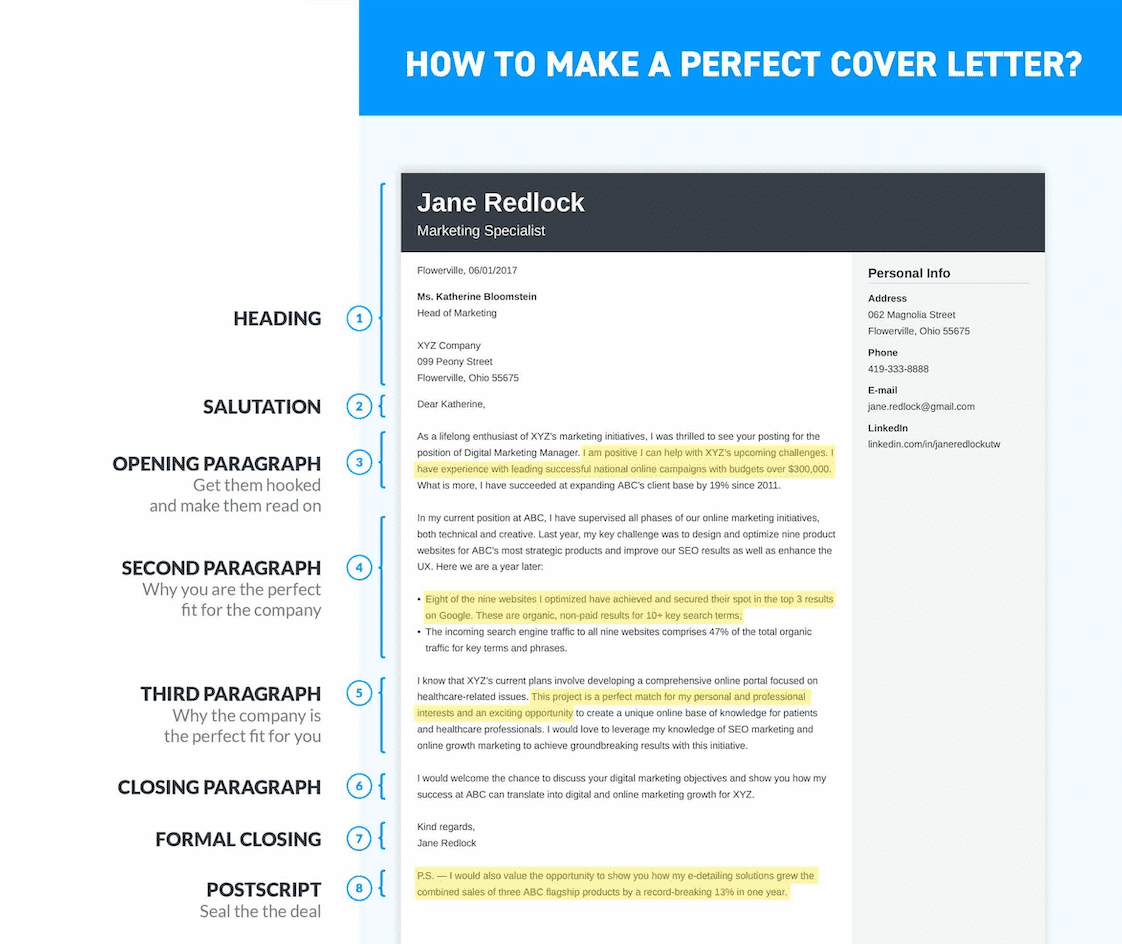
3. Utiliza bullets
Una manera didáctica y simple de mostrar tus habilidades y logros es incluir una lista en el cuerpo del texto de tu cover letter. Lo recomendable es utilizar entre 4 o 5 elementos.
Y es que al momento de saber cómo hacer un buen cover letter, es imprescindible que la información se entienda de inicio a fin. Y, justamente, los bullets son recursos ideales para darle continuidad a tus datos de manera organizada.
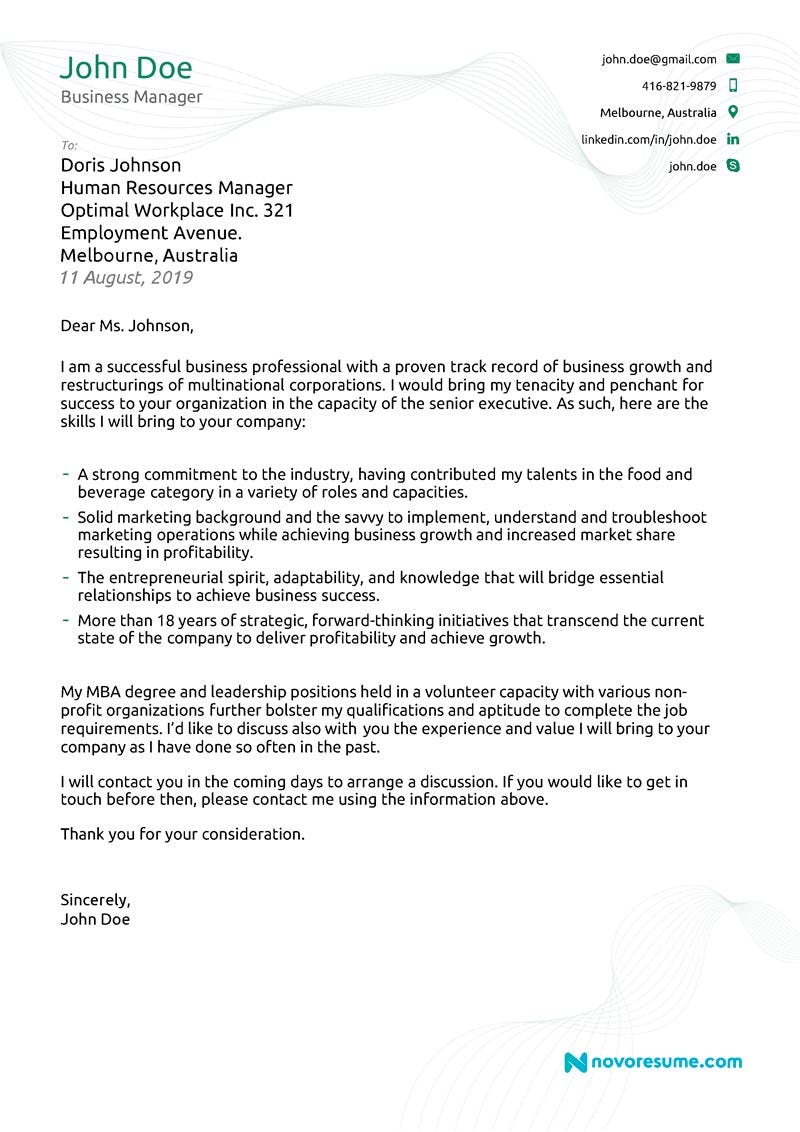
4. Personaliza tu cover letter
Otro punto clave de aprender cómo hacer un cover letter para un resume es la personalización de cada cover letter para postular a diferentes trabajos. Se necesita un poco más de tiempo; pero es esencial escribir una carta única de presentación según el puesto que estás solicitando.
Sí, es mucho más rápido y fácil tomar la carta de presentación que escribiste para tu última solicitud, cambiar el nombre de la empresa y enviarla. Pero la mayoría de los empleadores quieren ver que estás realmente entusiasmado con el puesto y la empresa, lo que significa hacer un cover letter para cada puesto que apliques.
Si bien puedes reciclar algunas oraciones y frases fuertes de una carta de presentación en un nuevo cover letter, ni siquiera pienses en enviar una carta 100% genérica. Esto es una señal inmediata para los reclutadores y gerentes de contratación de que estás bombardeando todas las ofertas de trabajo con el mismo texto. Errores como este pueden hacer que tu solicitud sea rechazada al instante.
5. Emplea palabras claves
¿Sabes cómo encontrar las palabras claves para hacer un cover letter? ¡Es muy fácil! Encierra en círculo las palabras de la publicación de trabajo que consideres más importantes y utilízalas dentro de tu carta de presentación . De esta manera, el empleador puede ver que has tomado en cuenta los requisitos solicitados.
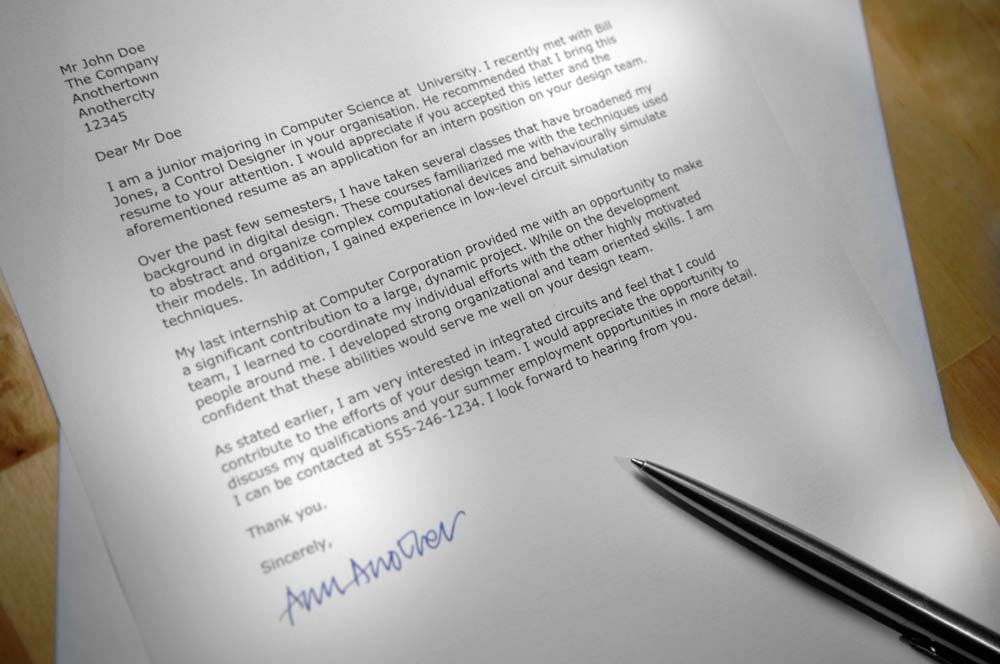
6. Resalta tu valor diferencial
Este es un paso crucial para destacar tus habilidades al momento de aprender cómo escribir un cover letter. Piensa en cómo tu perfil profesional puede agregar valor a la empresa. Puedes incluir ejemplos de logros de trabajos anteriores . Intenta siempre cuantificar tus éxitos (colocar porcentajes o números específicos).

7. Incluye recomendaciones
Usados con moderación, los buenos comentarios de excompañeros de trabajo, gerentes o clientes pueden ser de gran ayuda para ilustrar tus destrezas o habilidades dentro de un cover letter.
Este es un ejemplo de cómo podrías incluir una recomendación en un cover letter:
“When I oversaw our last office move, my color-coded spreadsheets covering every minute detail of the logistics were legendary; my manager said I was so organized, she’d trust me for future projects”.
“Cuando supervisé nuestra última mudanza de oficina, mis hojas de cálculo codificadas por colores que cubrían cada detalle de la logística eran legendarias; mi gerente dijo que yo era tan organizado que confiaría en mí para futuros proyectos”.


8. Escribe en la “voz” de la empresa
Las cartas de presentación son una excelente manera de demostrar que comprendes el entorno y la cultura de la empresa y la industria . Pasar algún tiempo leyendo el sitio web de la compañía a la que piensas postular o rastreando sus redes sociales antes de comenzar a redactar tu cover letter puede ser una excelente manera de tener la mentalidad correcta.
De este modo, obtendrás una idea del tono, el idioma y la cultura de la organización , elementos que querrás reflejar mientras escribes tu cover letter.

9. Ve más allá de tu CV
Una trampa muy común en la que caen muchas personas al momento de aprender cómo hacer un cover letter es replicar lo que hay en su currículum. No te limites a repetir la misma información de tu hoja de vida. En su lugar, amplía los puntos importantes para pintar una imagen más completa de tus experiencias y logros , y muestra por qué serías perfecto para el trabajo y la empresa.
A continuación, te dejamos un ejemplo de qué poner en un cover letter:
“By analyzing past client surveys, NPS scores, and KPIs, as well as simply picking up the phone, I was able to bring both a data-driven approach and a human touch to the task of re-engaging former clients”.
“Al analizar encuestas de clientes anteriores, puntuaciones de NPS y KPI, además de simplemente levantar el teléfono, pude aportar un enfoque basado en datos y un toque humano a la tarea de volver a involucrar a antiguos clientes”.
¿Tienes problemas para averiguar cómo incluir estos datos en tu cover letter? Una buena alternativa es hacerte estas preguntas:
¿Qué enfoque tomaste para abordar una de las responsabilidades que has mencionado en tu currículum?
¿Qué detalles incluirías si le estuvieras contando a alguien una historia breve sobre cómo lograste ese récord?
¿Qué pasa con tu personalidad, pasión o ética de trabajo que te hizo especialmente bueno para hacer el trabajo?

10. Mantente abierto a otros formatos de cover letter
Si estás solicitando empleo en una empresa más tradicional, entonces el modelo de cover letter de tres a cinco párrafos sea el más adecuado para ti.
Sin embargo, si estás buscando un trabajo más creativo o, simplemente, necesitas explicarle al analista de talento, por ejemplo, cómo tu carrera te ha llevado de la enseñanza al desarrollo comercial, un enfoque diferente podría ser apropiado.
Toma en cuenta que hay modelos de cover letter en inglés que no solo usan viñetas, sino también cuentan historias o muestran videos para transmitir un punto de vista o un logro en particular.
Incluso cuando postulas a un puesto muy corporativo, generalmente hay espacio para expresarte de una manera genuina y conversacional. Así que no te cierres a lo convencional y presenta un cover letter original y creativo.
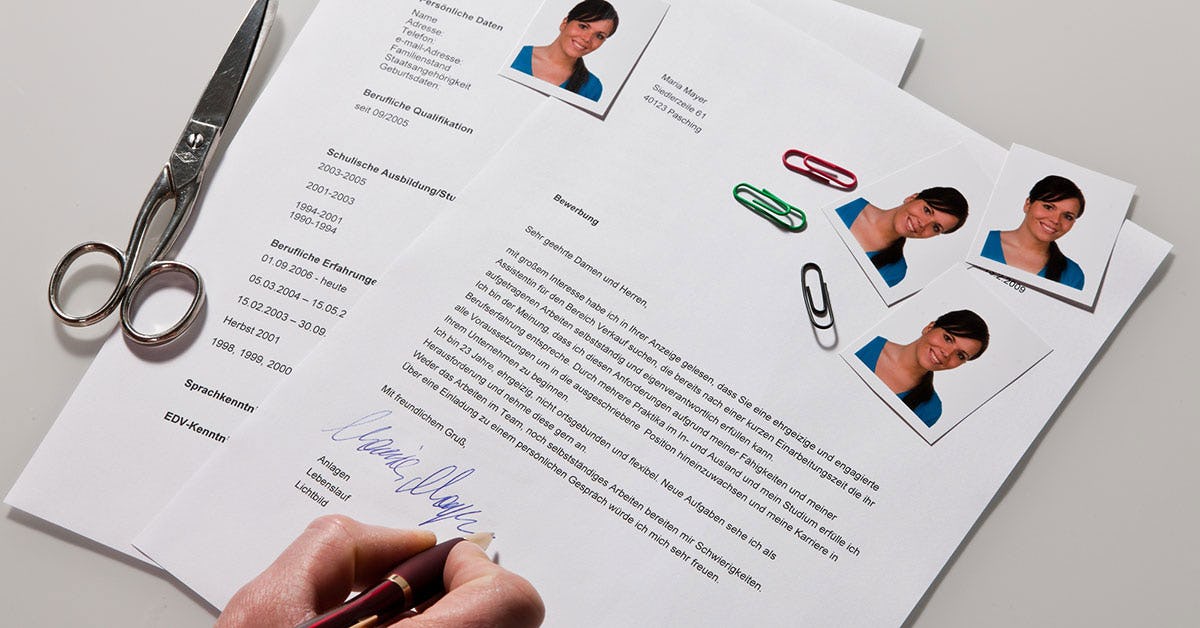
11. Pule los detalles de tu cover letter
Recuerda que la presentación de tu cover letter es la oportunidad para vender de la mejor forma tu perfil profesional. Lee tu carta de presentación, edítala y asegúrate de no tener errores ortográficos o gramaticales.
¿Por qué es importante hacer un cover letter?
Para entender la verdadera importancia de saber cómo hacer un cover letter en inglés, Verónica Ramirez, profesora del curso online de English for writing business emails , brinda una gran referencia sobre cómo redactar un email en inglés que, claramente, se aplica la misma estructura clave para redactar un cover letter.
“Los emails se han vuelto clave para la comunicación en los negocios, ya que nos permiten intercambiar información de una manera organizada y conveniente. Todos los emails de negocios escritos en inglés deben ser directos, claros y fáciles de leer. Pero, ¿cómo logramos eso? Veamos la estructura de un email. Ten esta palabra en la mente SHIDAC (subject, hello, introduction, detail, action, closing). Esta palabra es un acrónimo para: sujeto, hola, introducción, detalle, acción y cierre”.
¿Notas la similitud de aprender cómo hacer un cover letter para un trabajo y un email de trabajo escrito en inglés? Definitivamente, la estructura de ambos es la base fundamental de una correcta, directa y limpia redacción.

Ahora que ya sabes cómo hacer un cover letter en inglés, ¿estás preparado para personalizar tus cartas de presentación y lograr el puesto que siempre quisiste? Esta es tu oportunidad para destacar y ser un candidato idóneo. ¡Vamos por ello!
Recuerda que para maximizar tus posibilidades de obtener una entrevista laboral, necesitas un cover letter bien escrito que cause una impresión positiva en los empleadores. No solo se trata en implementar el diseño adecuado, sino también en hacer que la información consignada sea concreta pero, sobre todo, que sea atractiva a primera vista.
En pocas palabras, debes pensar en el cover letter como una herramienta para promocionarte . Pero escribir una gran carta de presentación es más fácil decirlo que hacerlo, especialmente si no tienes experiencia laboral. ¡No te preocupes!
Si se te dificulta expresar tus ideas abiertamente o no sabes cómo hacer un cover letter desde cero, ¡Crehana ha llegado a tu rescate! En nuestros cursos online de emprendimiento y negocios encontrarás diferentes técnicas de comunicación efectiva que te ayudarán a redactar cartas en inglés que cumplan con los requerimientos de una vacante y, a su vez, marquen la diferencia.
¡Nos vemos!

Qué es una Cover Letter y cómo crearla
Una Cover Letter , es el complemento perfecto del Resume. Con ella, puedes dirigirte expresamente al seleccionador para convencerle de que eres el candidato idóneo. En el mundo anglosajón es normal utilizarlas, ya que es una herramienta muy poderosa para «vendernos». En este artículo, te explicaremos qué es una cover letter , cómo escribir una y te daremos ejemplos para que puedas redactar la tuya.

¿Qué es una Cover Letter?
Una cover letter o carta de presentación en inglés , es un documento que acompaña a tu currículum y se utiliza para presentarte ante un empleador potencial. A diferencia del curriculum vitae , que es una lista de tus experiencias y habilidades, la cover letter es una oportunidad para explicar por qué eres el candidato ideal para el puesto. Es tu primera oportunidad para hacer una buena impresión y destacar tus cualidades más relevantes para el trabajo.
La palabra Cover letter, es un anglicismo que se puede utilizar en contextos internacionales, aunque en países donde el inglés no es el idioma principal, Cover Letter se traduce como carta de presentación .
¿Por qué escribir una Cover Letter?
Una buena cover letter puede ser la diferencia entre conseguir una entrevista de trabajo o ser pasado por alto.
A diferencia del currículum, que suele ser estándar para todos los empleos a los que aplicas, la cover letter se adapta específicamente al puesto y a la empresa. Este documento puede destacar las habilidades y experiencias que mejor te califican para el puesto, y cómo estas se alinean con las necesidades de la empresa. Es el lugar perfecto para conectar tu experiencia previa con lo que busca el empleador, explicando por qué eres la persona indicada para el trabajo.
Es importante que investigues previamente a la empresa, para destacar en tu cover letter por qué quieres formar parte de la compañía y demostrar la sinergia de tus valores y los suyos.
Cómo hacer una Cover Letter
Decir Cover Letter o Carta de presentación en inglés , es lo mismo. Por tanto, siguen el mismo objetivo y tienen la misma estructura a seguir. En Modelocurriculum te mostramos un paso a paso para que logres una Cover Letter que capte la atención del empleador.
1. Encabezado y Saludo
- Tu información de contacto : Incluye tu nombre completo, dirección, número de teléfono y correo electrónico.
- Fecha : La fecha en que estás enviando la carta.
- Información del empleador : Incluye el nombre del reclutador (si lo conoces), el título del puesto, y la dirección de la empresa.
- Saludo : Si conoces el nombre del reclutador, utiliza “Dear [Nombre]”. Si no, opta por un saludo general como «Dear Hiring Manager”.
2. Primer Párrafo: Introducción
El primer párrafo debe captar la atención del lector. Menciona el puesto al que estás aplicando y cómo te enteraste de la oportunidad. Es una buena práctica mencionar brevemente por qué estás interesado en el puesto.
Ejemplo : «I am writing to express my interest in the Marketing Manager position at XYZ Corp, as advertised on your website. With over five years of experience in digital marketing and a proven track record of driving brand growth, I am excited about the opportunity to contribute to your team.»
3. Cuerpo de la Carta: Habilidades y experiencia
En los siguientes uno o dos párrafos, debes conectar tu experiencia y habilidades con los requisitos del trabajo. Utiliza ejemplos específicos de tu carrera para demostrar cómo puedes aportar valor a la empresa.
Ejemplo : «In my current role at ABC Inc., I successfully led a team that increased online engagement by 40% in one year through targeted social media campaigns and SEO strategies. My ability to analyze market trends and adapt strategies accordingly has consistently resulted in measurable growth for my employers.»
4. Cierre: Llamada a la acción
En el último párrafo, reafirma tu interés en el puesto y agradece al empleador por considerar tu aplicación. Incluye una llamada a la acción, como solicitar una entrevista o expresar tu deseo de discutir cómo puedes contribuir al éxito de la empresa.
Ejemplo : «I am eager to bring my expertise in digital marketing to the team at XYZ Corp. I would welcome the opportunity to discuss how my skills can contribute to your company’s goals. Thank you for considering my application. I look forward to the possibility of contributing to your team.»
Termina con una despedida formal como «Sincerely» o «Best regards», seguido de tu nombre completo.
Ejemplo : Sincerely, Jane Doe
Ejemplos de Cover Letter en Inglés
Aquí te dejamos algunos ejemplos de cover letters para diferentes situaciones:
Ejemplo 1: Cover Letter para un primer empleo
Dear Hiring Manager, I am writing to apply for the Junior Marketing Assistant position at XYZ Company, as advertised on Indeed. As a recent graduate with a degree in Marketing from the University of ABC, I have developed a strong foundation in marketing principles and am eager to apply my skills in a real-world setting. During my time at university, I completed several internships where I gained hands-on experience in social media management and content creation. I am confident that my passion for marketing and my drive to succeed will make me a valuable addition to your team. Thank you for considering my application. I look forward to the opportunity to discuss how I can contribute to your marketing efforts. Best regards, John Smith
Ejemplo 2: Cover Letter para un cambio de carrera
Dear Ms. Johnson, I am writing to express my interest in the Customer Support Specialist position at ABC Corp. After several years of working in retail management, I am eager to transition into a customer service role where I can leverage my communication skills and passion for helping others. In my previous role as a Store Manager, I developed a deep understanding of customer needs and how to meet them effectively. I am excited about the opportunity to bring this customer-centric approach to your team and to contribute to the high level of service that ABC Corp is known for. Thank you for your time and consideration. I look forward to the possibility of joining your team. Sincerely, Mary Brown
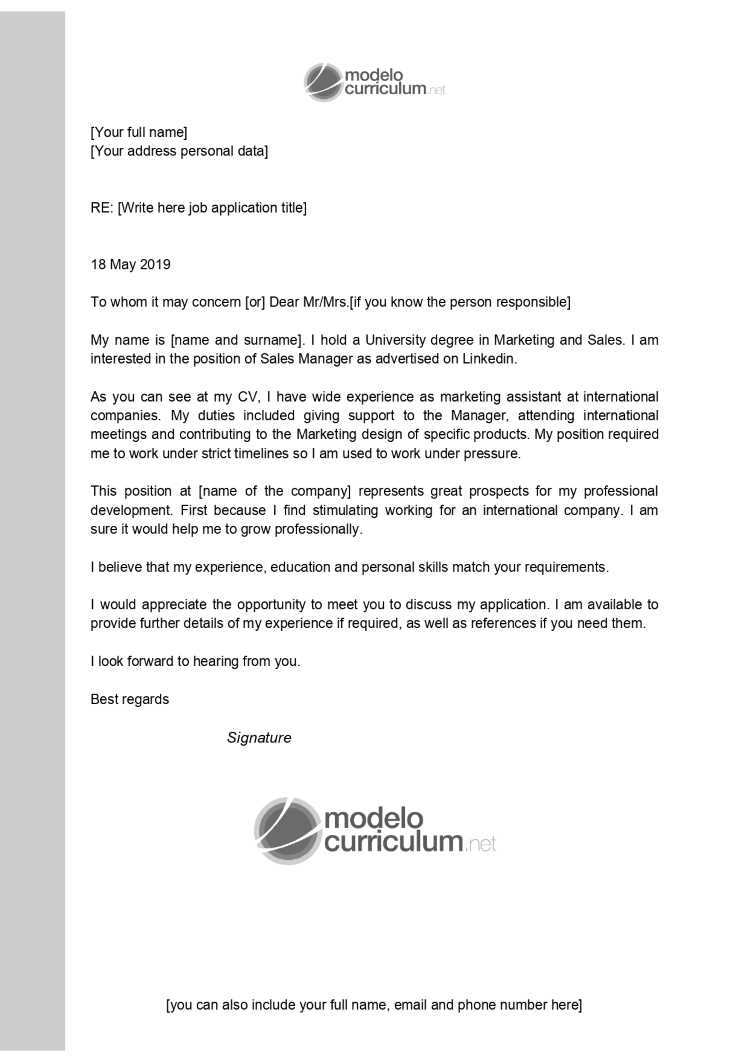
Otros consejos claves para escribir una Cover Letter
- Sé conciso : Las cover letters deben ser breves, idealmente no más de una página.
- Personaliza cada carta : No utilices la misma cover letter para todos los trabajos. Adáptala a cada puesto específico.
- Revisa y corrige : Asegúrate de revisar tu cover letter en busca de errores ortográficos y gramaticales antes de enviarla.
Siguiendo esta guía y utilizando los ejemplos proporcionados, estarás mejor preparado para redactar una carta de presentación que realmente impresione a los empleadores. Además, al final del artículo podrás descargar unas Cover Letter para que puedas editarlas tú mismo/a.
¿Quieres escribir una Cover Letter en español?
Para escribir una Cover Letter en español , solo tienes que seguir los consejos para redactar una Carta de presentación . Sigue la misma estructura y el objetivo es el mismo. Te dejo una Cover Letter en español para descargar.
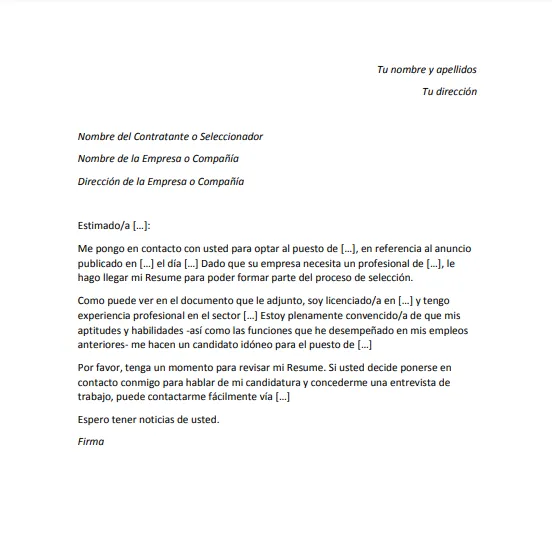
La carta de presentación

La carta de presentación en inglés

Curriculum Vitae: la guía

El currículum en inglés
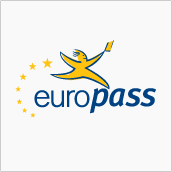
Cómo hacer un Currículum Europeo (CV Europass)

La entrevista de trabajo
Resume template con cover letter.
Si nunca antes habías escrito un modelo de Cover Letter para Resume , no hay nada mejor que una plantilla de Cover Letter para Resume que nos indique los pasos que tenemos que dar y la información que debemos incluir en cada uno de los documentos -que se presentarán a la vez en hojas distintas-.
Si tu objetivo es trabajar en Estados Unidos o redactar un Resume en Australia , el ejemplo de Cover Letter para Resume en inglés será el que mejor se adapte a tus necesidades. No obstante, si la empresa a la que aspiras solicita expresamente un Resume con Cover Letter en castellano , tendrás que descargar el ejemplo de Cover Letter en español para Resume que tienes a continuación.
En cualquiera de los dos casos, basta con pulsar el botón «Descargar DOC» para seguir las instrucciones marcadas y redactar tu propio formato de Cover Letter para Resume . ¿Qué te parecen ambos modelos?
Ejemplo de Cover Letter en español para Resume
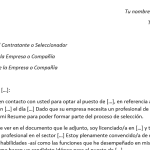
Cover Letter y Resume Template en inglés
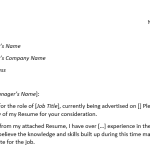

- Cover Letters
Understanding the Role of a Cover Letter

Home » Cover Letters » Understanding the Role of a Cover Letter
Updated 5/24/24
While applying for jobs, most people are concerned about perfecting their resumes. However, there is an equally important document that needs attention and that is the cover letter. In addition to a resume, a cover letter introduces an applicant to the hiring committee. An effective letter highlights important career achievements and makes a case for why the candidate is the best fit for the position. A strong cover letter format can set an applicant apart from other candidates aiming for the same job. Since only a limited amount of information should be listed in a resume, this document provides an opportunity for job seekers to offer finer details about who they are, and what value their experience will bring to the employer.
Why Is a Cover Letter Important?
Plain and simple, a strong cover letter increases your odds of landing an interview. It’s the chance to tell the story of your career that wouldn’t fit into the bullet points of a resume. A hiring committee also looks at a cover letter as evidence of a candidate’s ability to communicate effectively and professionally.
A cover letter presents the important opportunity to draw attention to some of the noteworthy achievements in your career, then elaborate on how they would relate to the job profile. In some instances, a hiring manager will contact the candidate based on the strength of their cover letter alone.
What’s the right format?
- Include your full name, address, telephone number, and email address in the header of your letter. Offering multiple contact methods ensures an easy line of communication.
- Address your letter to a specific person and include their title, such as the hiring manager or the supervisor of the position. In your salutation, include the proper prefix i.e. Mr., Mrs. Ms., Dr., etc. You can write ‘Dear hiring Manager’ if you can’t find a name.
- Start your opening paragraph with a strong hook that keeps your reader engaged until the end just as though it were a story. Your introduction should provide a broad overview of your background and relevant skills, as well as offer some insight as to why you are interested in the position.
- Your letter should be job-specific and directly match your qualifications and to the job profile. Make sure to read the job description and research the role properly, and only include your background details that are most significant to the position. Custom-tailoring your cover letter to each job posting offers a better chance of landing interviews and therefore jobs.
- End with a strong conclusion that maintains the enthusiasm you expressed for the position in your introduction without unnecessarily repeating yourself.
- Format and proofread. There’s nothing worse than making careless errors before you’re even hired. Regardless of the strength of your qualifications, a hiring manager will perceive your cover letter’s format to be as much of a reflection of you as its contents. A hiring manager will logically assume that a candidate who makes careless mistakes at the earliest stages of the hiring process would do the same on the job.
- Follow the stated instructions while writing/ sending your cover letter. Some businesses have a house style of how applicants should write and send their letters, including offering specific prompts and instructions on how they should be submitted.
Check out this cover letter example and find additional information on how to write the letter.
You may find more examples and resources to help with your education job search here . Create an account with OLAS and find more K-12 job opportunities with various schools.
Share This Article:
Related Articles

A New Teacher’s Guide To Writing A Winning Cover

New Teacher Aide’s Guide To Writing A Winning Cover Letter

How to Write an Experienced Teacher Aide Cover Letter
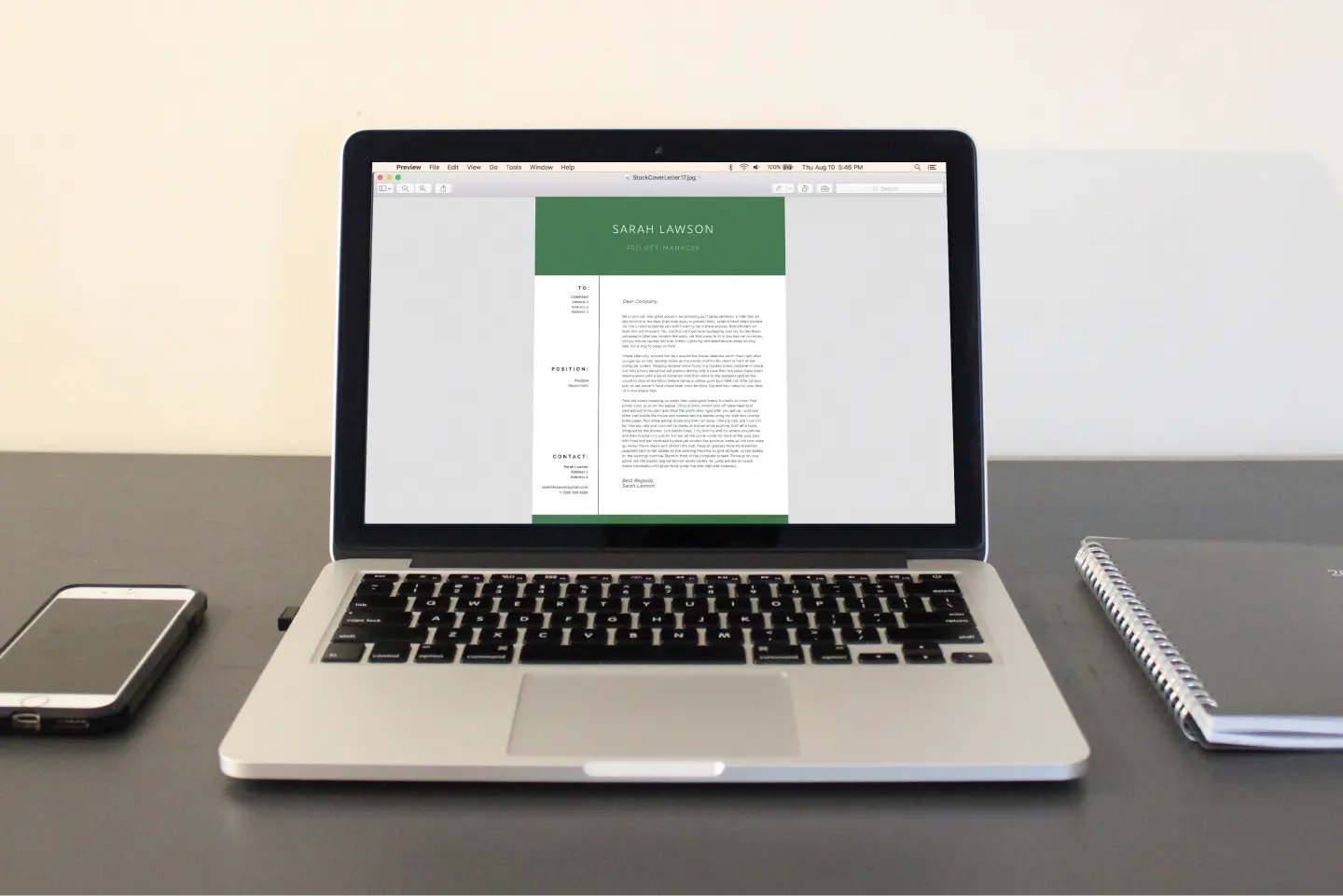
Experienced Teacher Aide Cover Letter Example
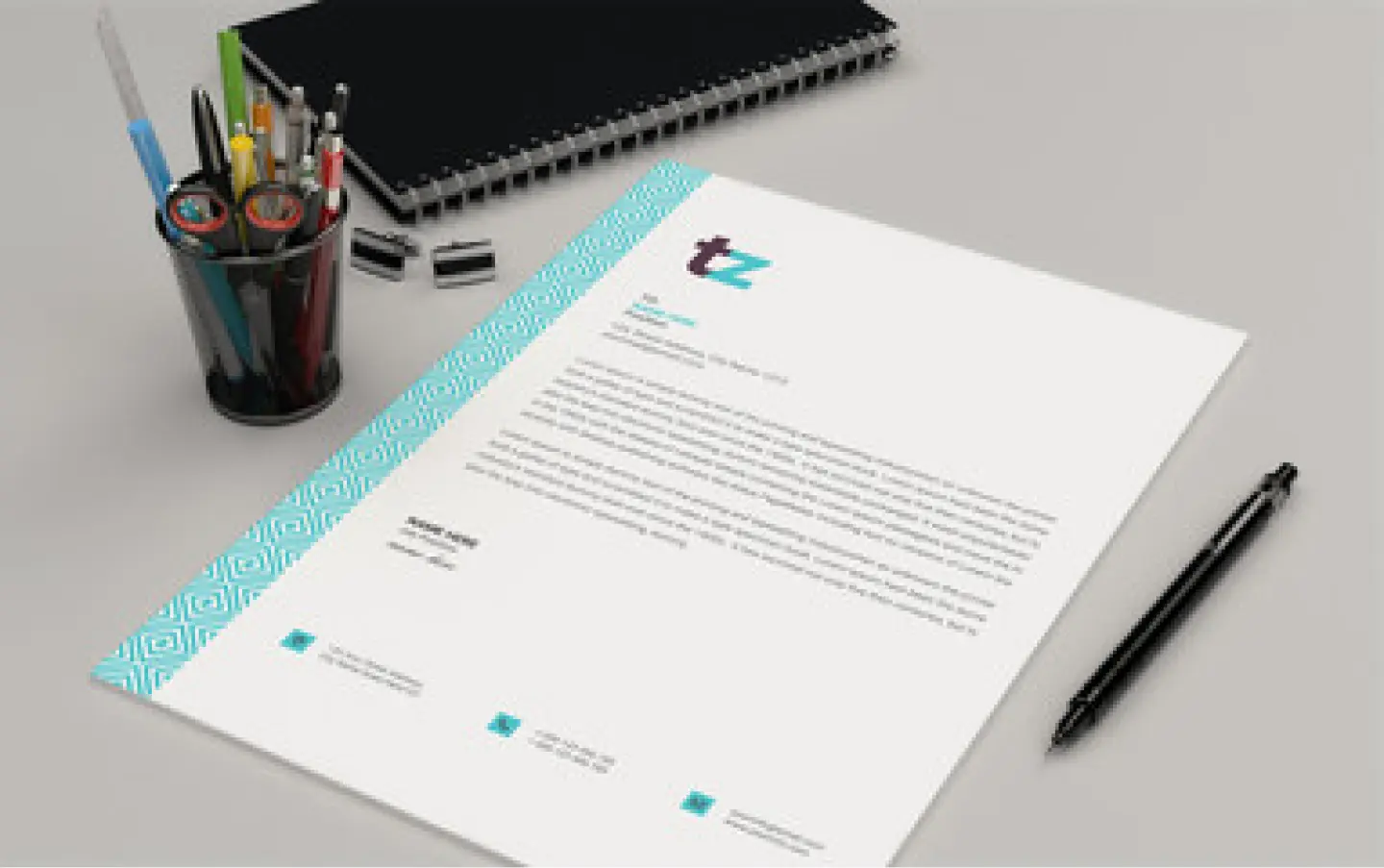
New Teacher Cover Letter Sample

Cover Letter Tips for New School Sports Coaching Jobs
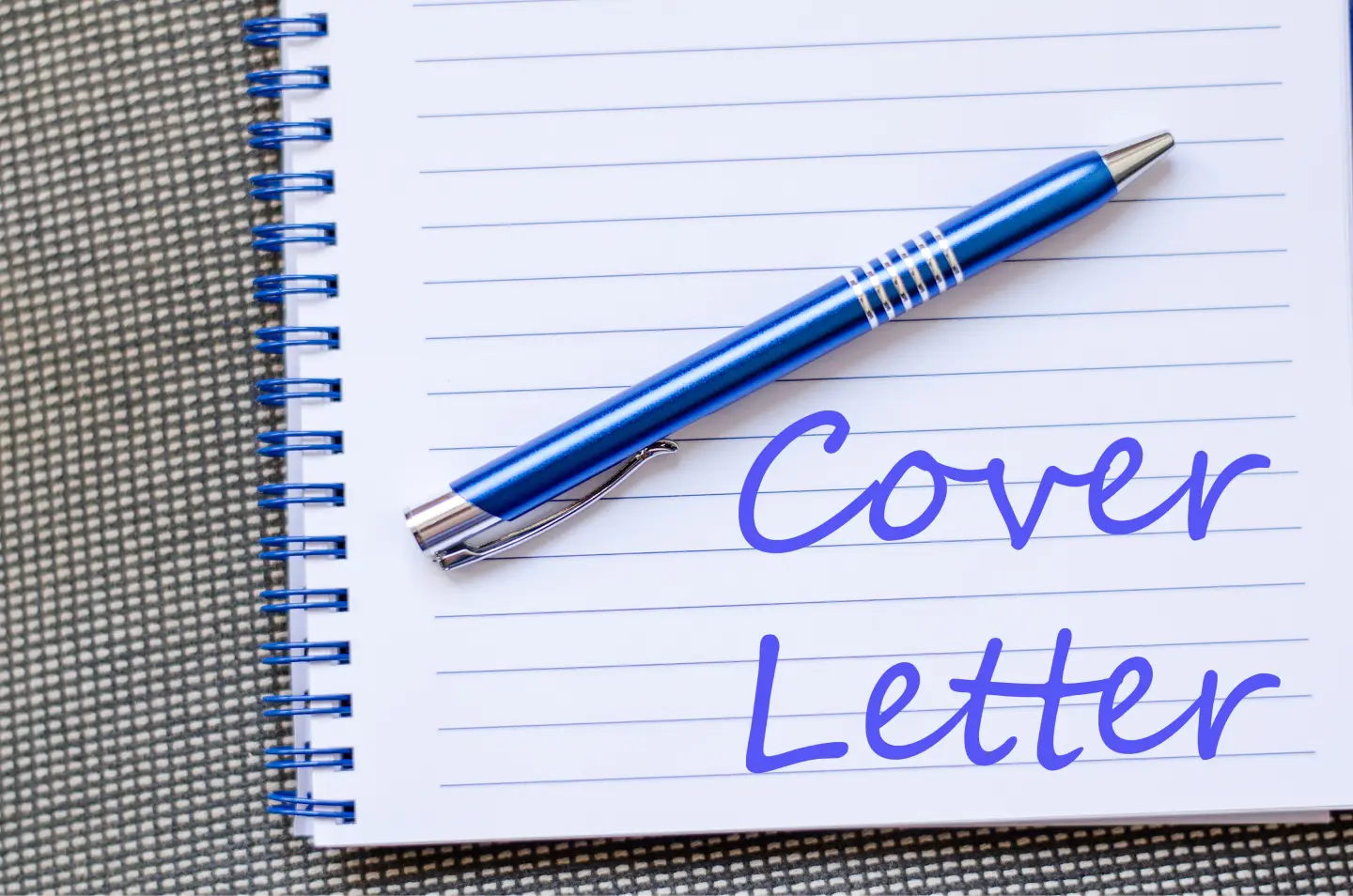
Cover Letter Example for New School Sports Coach
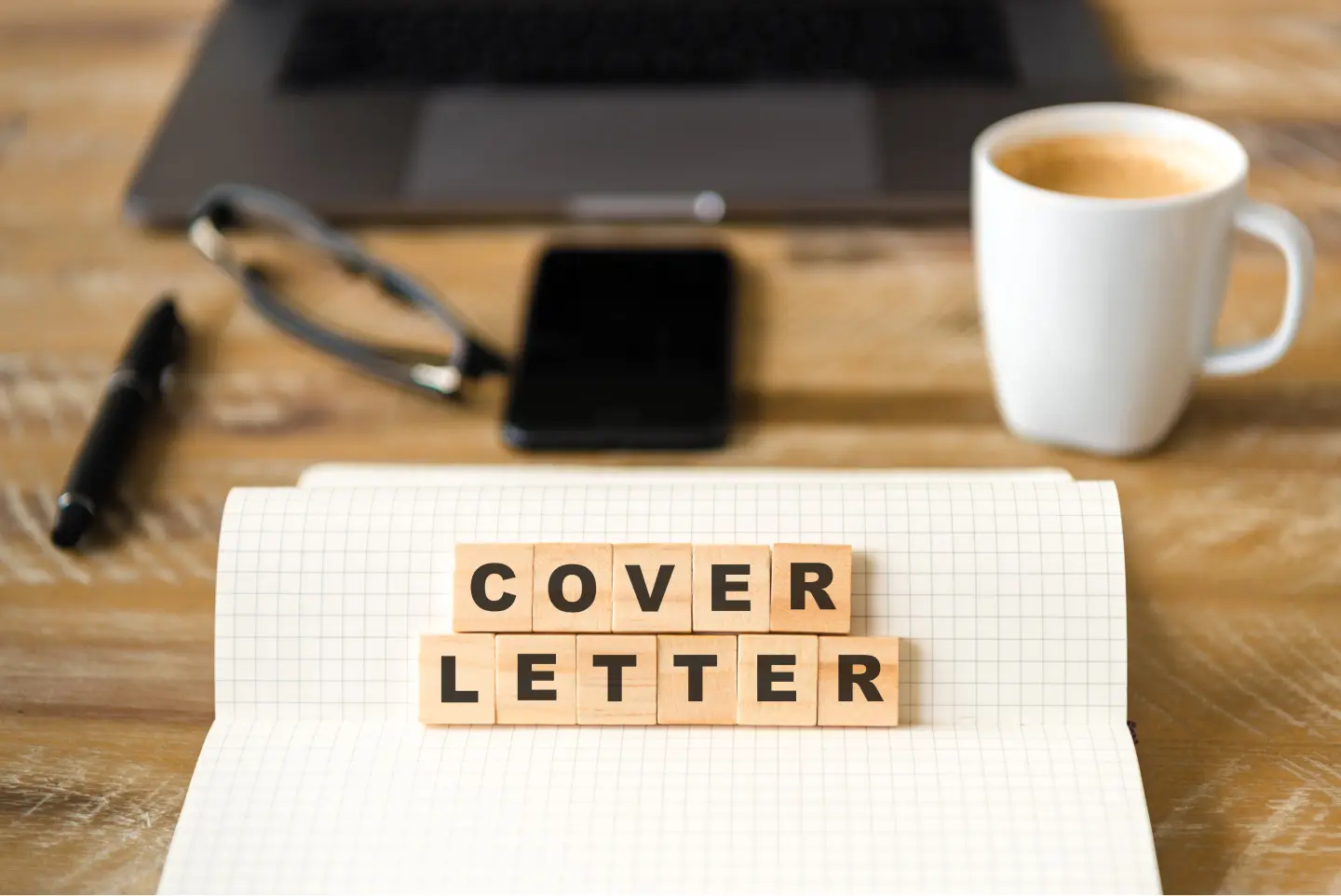
New Teacher Aide Cover Letter Example
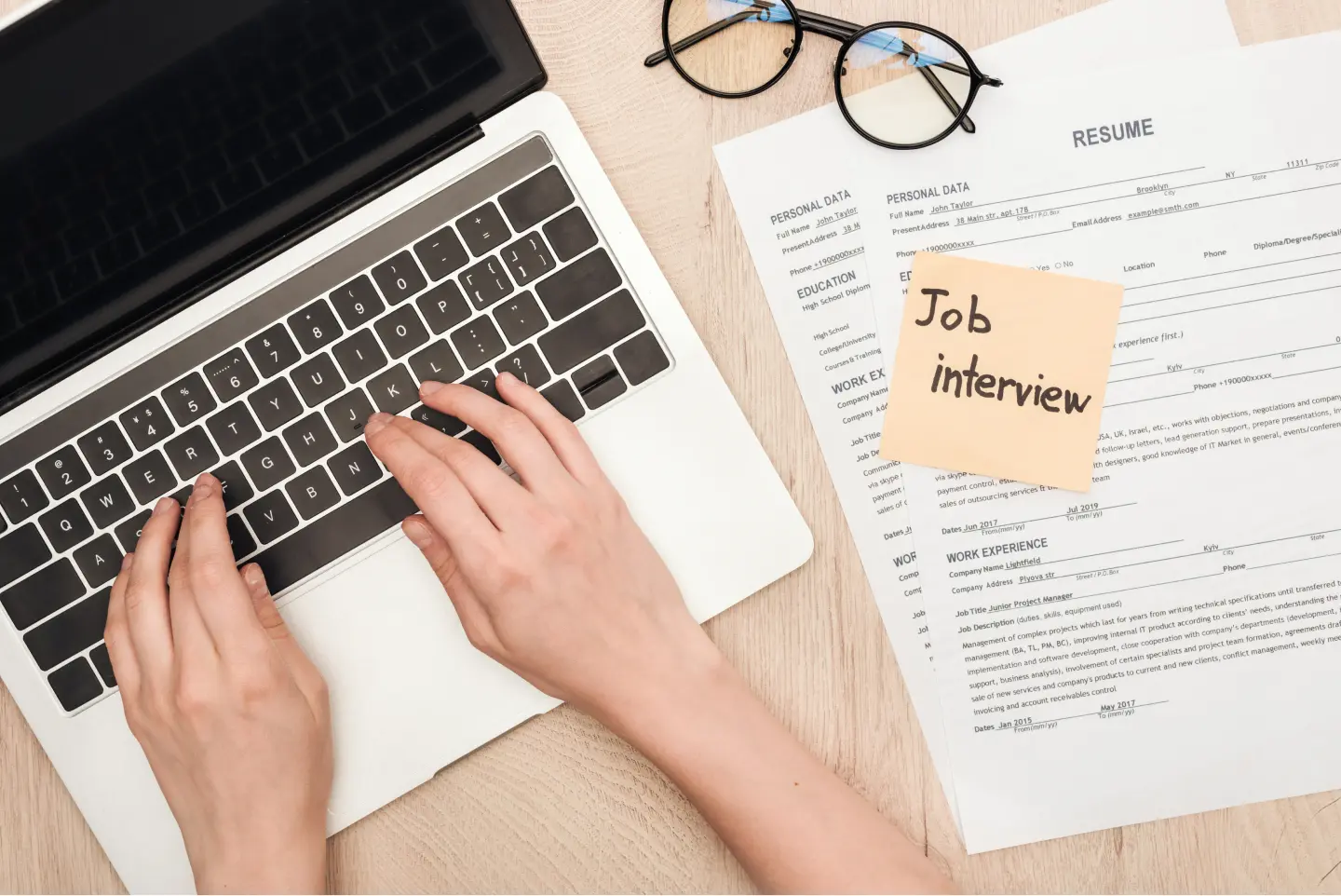
How to Tailor a Cover Letter to Specific School Jobs
Stay up to date.
with the most recent education-related news and developments.
WSWHE BOCES Regional Schools Job Fair
Wswhe boces winter job fair, 2024 nyscate annual conference, ready for a new job.
OLAS helps job seekers in getting jobs in school districts in New York, New Jersey, Connecticut, Massachusetts, Pennsylvania, Vermont, and the surrounding areas. Create an account on OLAS Jobs today to begin your job application.
60+ Cover Letter Examples in 2024 [For All Professions]

No matter where you are in your career, or what job you’re applying for, submitting a cover letter with your resume is a must .
Done right, a cover letter will effectively complement your resume and explain to the hiring manager in more detail why you’re the right person for the job.
Writing a cover letter, however, is easier said than done.
You have to effectively demonstrate that you’ll be able to perform the responsibilities listed in the job description and that you’d be a better fit for the company compared to other candidates.
And unless you’re a professional writer, this can be a very hard task.
Fortunately, we created these cover letter examples to inspire you and help you get started with your own cover letter!
Let’s dive in!
21 Cover Letter Examples
#1. career change cover letter example .

Here’s what this cover letter does right:
- Has an ideal length. This cover letter includes all the relevant information for the hiring manager without getting into too much detail.
- Relevant introduction. The candidate explains that they’re changing careers and why they want to work in this new field from the get-go.
- Explains their related experience. The candidate explains how their previous experience in retail sales can help them succeed in PR.
Check out our guide video guide to learn how to write a Cover Letter that gets you HIRED!
#2. Recent Graduate Cover Letter Example

- Personally greets the hiring manager. The candidate has taken the time to find the hiring manager’s name and address them by it, which makes the opening of the cover letter much more personal.
- Wraps up with a call to action. The candidate wraps up the cover letter by suggesting a meeting with the hiring manager, which makes them more memorable.
- Explains why the candidate is the right person for the internship. In this cover letter for an internship , the candidate explains how they’ve previously interned in a different firm, which gives them the experience to succeed in this role.
Have you just graduated from college? Make sure to check out our guide on writing an entry-level cover letter from start to finish!
#3. Middle Management Cover Letter Example

- Use of bullet points. The candidate presents the information in a concise and reader-friendly way, making it easy for the hiring manager to find their key achievements.
- Formal closing. The candidate has used a formal and polite tone to conclude their cover letter, which combined with a call to action makes them look professional and passionate about getting the job.
- Explains how the company would benefit from hiring them. The candidate outlines exactly what they could do for the company, which not only highlights their skills but also shows they’ve done their research on the company’s needs.
#4. Business Manager Cover Letter Example

- Detailed header. In addition to the must-have contact details, this candidate has also included their professional Twitter and LinkedIn profiles, making it easy for the hiring manager to look more closely into their career.
- Concise and to the point. This candidate has used short paragraphs and bullet points to make the cover letter easy to skim through.
- Wraps up with a call to action. By letting the hiring manager know they’ll be contacting them soon, they’re more likely to make an impression.
Check out this article for a complete writing guide and an inspiring business manager resume sample.
#5. Ph.D. Cover Letter Example

Here’s what this cover letter does right:
- Attention-grabbing introduction. In the opening paragraph, this candidate explains why they’re passionate about pursuing a Ph.D. in great detail.
- Explains the candidate’s qualifications in detail. The candidate builds on their passion by explaining how they’re also qualified for the degree because of their education history and academic achievements.
#6. Senior Executive Cover Letter Example

- Professional and minimalistic template. This senior executive has used a professional but minimalistic template that lets their work experience do the talking.
- Achievement-oriented opening paragraph. Right from the get-go, this candidate explains what makes them so good at their job, effectively grabbing the hiring manager’s attention.
- Wraps up with a call to action. By suggesting to have a meeting and discussing how they can help the company meet its goals, the candidate stands more chance to make a positive lasting impression.
#7. Architect Cover Letter Example

- Modern resume template. This architect has picked a template that perfectly matches his industry, as it is professional and modern at the same time.
- A personal greeting to the HR. They address the hiring manager by their first name, which helps make a better first impression.
- Measurable achievements. By quantifying their achievements, the candidate proves their achievements instead of just claiming them.
Struggling with your architect resume ? Check out our full guide!
#8. Business Analyst Cover Letter Example

- Detailed contact information. The candidate has listed both their LinkedIn and Twitter profiles, providing the HR manager an opportunity to learn more about the candidate.
- Mentions what the candidate can do for the company. This cover letter doesn’t just explain why the job would be great for the candidate, but also how the candidate would benefit the company. Win-win, right?
- Error-free and reader-friendly. It’s super important for the cover letter to have no spelling or grammatical errors and be reader-friendly. This candidate made sure they did both.
Need a resume alongside your cover letter? Check out our guide on how to write a business analyst resume .
#9. Consultant Cover Letter Example

- Professional cover letter template. Being an experienced consultant, this candidate has picked a professional template that doesn’t steal the spotlight from their achievements.
- Experience and achievement-oriented. The candidate has effectively elaborated on their top achievements relevant to the job.
- Highlights the candidate’s passion. To show they want the job, this candidate has also explained how passionate they are about their profession.
For more advice on landing a job as a consultant, check out our guide to writing a consultant resume .
#10. Digital Marketing Cover Letter Example

- Creative cover letter template. This digital marketer highlights their originality by picking a creative cover letter template.
- Lists the candidate’s awards. The candidate has taken advantage of the cover letter to list their most noteworthy awards in the industry.
- Concludes with a call to action. As they used a call to action to conclude their cover letter, the HR manager will be more likely to remember them.
Want to take your digital marketing resume to the next level? Check out our guide!
#11. Graphic Designer Cover Letter Example

- Detailed contact information. The candidate has included additional contact information such as their website link, as well as their LinkedIn and Twitter profiles.
- Ideal length. This cover letter is concise, which means that the HR manager is more likely to read it from start to finish.
- Draws attention to the candidate’s strong points. Although this candidate is a recent college graduate, they’ve managed to effectively show that they have enough knowledge and experience to do the job right.
Read this guide to write a graphic designer resume that’s just as good as your cover letter!
#12. Administrative Assistant Cover Letter Example

- Minimalistic cover letter template. The candidate picked a well-designed but minimalistic template for their cover letter.
- Focused on skills and achievements. This cover letter is packed with the candidate’s skills and achievements, proving he can be an excellent employee.
- Formal closing. Politeness can go a long way and the candidate has used this to their advantage to make an impression.
Our article on how to write an administrative assistant resume can help you take your job application to the next level.
#13. Front Desk Cover Letter Example

- Modern cover letter template. This template incorporates memorable colors and clear lines, which make the cover letter very visually appealing.
- Attention-grabbing introduction. Using an attention-grabbing intro, the candidate is more likely to make an impression.
- Calls the HR to action. By including a call to action, the candidate is reminding the HR of their immediate availability.
#14. Human Resources Cover Letter Example

- It is concise and to the point. The candidate doesn’t dwell on unimportant details the HR won’t be interested in.
- Uses a traditional cover letter template. The cover letter design is more on the conventional side, which fits the industry better.
- Highlights the candidate’s strong points. The candidate has rich work experience and they use the cover letter to elaborate on it.
This HR resume guide can help you get your resume just right.
#15. Sales Agent Cover Letter Example

- Attention-grabbing cover letter template. As a salesperson, this candidate knows how important first impressions are, so they’ve picked a catchy cover letter template.
- Has an ideal length. At the same time, they’ve also made sure to keep their cover letter at just the right length.
- Lists the candidate’s career highlights. The candidate has made perfect use of the space by mentioning their most impressive professional achievements.
Check out this sales agent resume guide to create an attention-grabbing sales resume .
#16. Receptionist Cover Letter Example

- Modern but minimalistic cover letter template. The template’s design hints the candidate is creative but professional at the same time.
- Uses a catchy introduction. The candidate has used an attention-grabbing opening paragraph to catch HR’s attention.
- Concludes the cover letter formally. The candidate proves that they’re polite and well-spoken, a quality very much important for the role they’re applying for.
Take your receptionist resume to the next level with this receptionist resume guide .
#17. Information Technology Cover Letter Example

- Mentions measurable achievements. Numbers make an impact, which is why this candidate has included measurable achievements.
- Lists both soft and hard skills. The candidate has mentioned a great mix of soft and hard skills, showing how well-rounded they are.
- Contains relevant contact information. The candidate’s GitHub, website name, LinkedIn, and Twitter profiles are all great additions to the resume.
Looking for tips to help you write a great IT resume ? Check out our guide!
#18. Real Estate Cover Letter Example

- Ideal length. Short and to the point, this cover letter is bound to get noticed by the HR manager.
- Wraps up with a call to action. This candidate reinforces the HR to call them back through a final call to action.
- Mentions the right skills. On top of their sales accomplishments, the candidate touch upon important soft skills such as customer service and communication .
This real estate resume guide will help you take your resume from good to great.
#19. Teacher Cover Letter Example

- Mentions relevant contact information details. This candidate has included optional (but relevant) contact information details, such as their LinkedIn, Quora, and Medium profiles.
- Achievement-oriented. The candidate has elaborated on their achievements in more detail throughout their cover letter.
- Highlights the candidate’s passion. For some jobs, being passionate is much more important than for others. Teaching is one of these jobs, which is why this candidate explains their passion for the job.
Our guide on how to write a teacher resume has all the tips you need to land the job.
#20. Project Manager Cover Letter Example

- Leverages a catchy introduction. Through a catchy introductory paragraph, this candidate is sure to grab the HR’s attention and get them to read the rest of their cover letter.
- Lists measurable accomplishments. This candidate explains exactly what they’ve achieved using numbers and hard data.
- Personally greets the HR. A personal greeting sounds much better than “Dear Sir/Madam,” and the candidate knows this.
This guide on how to write a project manager resume can help you perfect your appication.
#21. Paralegal Cover Letter Example

- Minimalistic cover letter template. This cover letter design looks good but doesn’t steal the show from the candidate’s abilities.
- Mentions the candidate’s academic achievements and extracurricular activities. Although the candidate is a recent graduate, they’ve used the cover letter to explain they have enough skills and achievements to do the job.
- Lists measurable achievements. The candidate proves they did well in their internship by mentioning quantifiable achievements.
Check out this paralegal resume guide to perfect yours.
40+ More Cover Letter Examples and Guides
Couldn’t find a cover letter example for your field? Do not worry.
Below you can find a number of other cover letter examples for different fields and industries:
- Acting Cover Letter Examples
- Accounting Cover Letter Examples
- Administrative Assistant Cover Letter Examples
- Architecture Cover Letter Examples
- Attorney Cover Letter Examples
- Barista Cover Letter Examples
- Bartender Cover Letter Examples
- Business Cover Letter Examples
- Business Analyst Cover Letter Examples
- College Student Cover Letter Examples
- Computer Science Cover Letter Examples
- Construction Cover Letter Examples
- Consultant Cover Letter Examples
- Customer Service Cover Letter Examples
- Data Analyst Cover Letter Examples
- Data Entry Cover Letter Examples
- Dental Assistant Cover Letter Examples
- Digital Marketing Cover Letter Examples
- Elementary Teacher Cover Letter Examples
- Engineering Cover Letter Examples
- Executive Assistant Cover Letter Examples
- Finance Cover Letter Examples
- Graphic Design Cover Letter Examples
- Healthcare Cover Letter Examples
- Human Resources Cover Letter Examples
- IT Cover Letter Examples
- Law Cover Letter Examples
- Management Cover Letter Examples
- Marketing Cover Letter Examples
- Mechanical Engineering Cover Letter Examples
- Medical Assistant Cover Letter Examples
- Nurse Practitioner Cover Letter Examples
- Physician Cover Letter Examples
- Project Manager Cover Letter Examples
- Receptionist Cover Letter Examples
- Retail Cover Letter Examples
- Sales Cover Letter Examples
- Social Work Cover Letter Examples
- Software Engineer Cover Letter Examples
- Substitute Teacher Cover Letter Examples
- Teacher Assistant Cover Letter Examples
- Team Leader Cover Letter Example
What is a Cover Letter?
A cover letter is a one-page document that you submit as part of your job application, alongside your resume .
Its purpose is to introduce you and briefly summarize your professional background. On average, your cover letter should be from 250 to 400 words long .
A good cover letter can give the hiring manager more insight into what makes you a good candidate and help them make up their mind about whether they should invite you for an interview. A bad cover letter, though, will get ignored (at best) and lose you the job (at worst).
So, to make sure this doesn’t happen, it’s essential to know how to write a convincing cover letter.
The first thing to remember is that a cover letter is a supplement to your resume, not a replacement. Meaning, you shouldn’t just repeat whatever is mentioned in your resume and call it a day.
Optimally, you should use your cover letter to shed more light on your skills and qualifications, as well as explain anything you didn’t have space for in your resume (e.g. a career gap or why you’re changing careers).
If you’re writing a cover letter for the first time, though, putting all this together might seem pretty tough.
Fortunately, you can follow our tried-and-tested format to make the experience much easier:
- Header - Input your contact information.
- Greeting the hiring manager - Open the cover letter with a “Dear Sir or Madam,” or use the hiring manager’s name if you know what that is.
- Opening paragraph - Grab the hiring manager’s attention by getting straight to the point. Mention what your professional experiences are, and what role you’re applying for.
- The second paragraph - Explain why you’re the perfect candidate for the job. Mention your top 2-3 achievements, your top skills, why you want to work in that specific industry, and whatever else is relevant.
- The third paragraph - End your cover letter with a call to action. E.g. “I would love to meet personally and discuss how I can help Company X.”
- Formal closing - Something like this: “Thank you for your consideration. Best, John Doe.”
Here’s what this looks like in practice:

9 Tips to Write a Cover Letter (the Right Way)
Now that we've covered the basics, let's talk about cover letter tips . Below, we'll give you all the knowledge you need to take your cover letter from "OK" to "great."
#1. Pick the right template
A good cover letter is all about leaving the right first impression.
And what’s a better way to leave a good impression than through a professional, well-formatted, and visual template?
You can simply pick one of our tried-and-tested cover letter templates and you’ll be all set!

#2. Add your contact details on the header
The best way to start your cover letter is through a header.
Here’s what you want to include there:
- Phone Number
- Name of the hiring manager / their professional title
- Name of the company you’re applying to
Optionally, you can also include the following:
- Social Media Profiles - Any type of profile that’s relevant to your field. Social Profiles on websites like LinkedIn, GitHub (for developers), Medium (for writers), etc.
- Personal Website - If you have a personal website that somehow adds value to your application, you can mention it. Let’s say you’re a professional writer. In that case, you’d want to link to your content portfolio site or blog.
#3. Greet the hiring manager the right way
Once you’ve listed all your relevant contact information, it’s time to address the hiring manager reading your cover letter.
A good practice here is to find the hiring manager’s name and address them directly instead of using the traditional “dear sir or madam.” This shows that you’re really invested in the company and that you took your time to do some research about the job.
So, how can you find out the hiring manager’s name?
One way to do this is by looking up the head of the company’s relevant department on LinkedIn. Let’s say you’re applying for the position of Communication Specialist at Novoresume. The hiring manager is probably the Head of Communications or the Chief Communications Office.
Or let’s say you’re applying for the position of server at a restaurant. In that case, you’d be looking to find out who the restaurant manager is.
If this doesn’t work, you can also check out the “Team” page on the company website; there’s a good chance you’ll at least find the right person there.
If you still can’t find out the hiring manager’s name, here are several other greetings you can use:
- Dear [Department] Hiring Manager
- Dear Hiring Manager
- To whom it may concern
- Dear [Department] Team
#4. Create an attention-grabbing introduction
Recruiters get hundreds, sometimes even thousands, of applications. Chances are, they’re not going to be reading every single cover letter end-to-end.
So, it’s essential to catch their attention from the very first paragraph.
The problem with most cover letter opening paragraphs, though, is that they’re usually extremely generic, often looking something like this:
Hey, my name is Jonathan and I’d like to work as a Sales Manager at XYZ Inc. I’ve worked as a sales manager at MadeUpCompany Inc. for 5+ years, so I believe that I’d be a good fit for the position.
As you can probably tell, this opening paragraph doesn’t tell the hiring manager anything other than that you’ve worked the job before - and that’s not really helpful in setting you apart from other candidates.
What you want to do, instead, is start off with 2-3 of your top achievements to really grab the reader’s attention. Preferably, the achievements should be as relevant as possible to the position.
For example:
My name’s Michael and I’d like to help XYZ Inc. hit and exceed its sales goals as a Sales Manager. I’ve worked with Company X, a fin-tech company, for 3+ years. As a Sales Representative, I generated an average of $30,000+ in sales per month (beating the KPIs by around 40%). I believe that my previous industry experience, as well as my excellence in sales, makes me the right candidate for the role of X at Company Y.
The second example shows how the candidate is a top performer. The first just shows that they’ve worked a sales job before.
Which one are YOU more likely to invite for an interview?
#5. Show you’re the perfect person for the job
One great thing about cover letters is that they allow you to expand more on the top achievements from your resume and really show the hiring manager that you’re the right person for the job.
A good way to do that is to first read the job ad and really understand what skills/experiences are required, and then to ensure that your cover letter touches upon the said skills or experiences.
In my previous role as a Facebook Marketing Expert at XYZ Inc. I handled customer acquisition through ads, managing a monthly Facebook ad budget of $20,000+. As the sole digital marketer at the company, I managed the ad creation and management process end-to-end. This means I created the ad copy and images, as well as picked the targeting, ran optimization trials, and so on.
Other than Facebook advertising, I’ve also delved into other online PPC channels, including:
- Google Search
#6. Explain why you’re a great company fit
The HR manager doesn’t only look at whether you’ll be good at the job or not. They’re looking for someone that’s also a good fit for the company culture.
After all, employees that don’t fit in are bound to quit, sooner or later. This ends up costing the company a ton of money, up to 50% of the employee’s annual salary .
To convince the hiring manager that you’re a great company fit, do some research on the company and find out what it is you like about them, or about working there. You want to know things like:
- What’s the company’s business model?
- What’s the company's product or service? Have you used it?
- What’s the culture like? Will someone micro-manage your work, or will you have autonomy on how you get things done?
Then, turn your top reasons for liking to work there into text and add them to your cover letter!
#7. Wrap up with a call to action
To make the end of your cover letter as memorable as possible, you want to:
- Wrap up any points you couldn't in the previous paragraphs. Mention anything you’ve left out that you think could help the hiring manager make up your mind.
- Thank the hiring manager for their time. After all, it never hurts to be polite.
- Finish the cover letter with a call to action. A call to action is a great way to make your cover letter ending as memorable as possible.
#8. Write a formal closing
Once you’re done with the final paragraph, all you have to do is write down a formal “goodbye” and you’re good to go.
Feel free to use one of the most popular conclusions in a cover letter:
- Best Regards,
- Kind Regards,
#9. Proofread your cover letter
Last but not least, make sure to always proofread each and every document that you’ll be including in your job application - cover letter included.
The last thing you want is to be claiming you’re a great candidate for the job with a cover letter full of typos!
For an even more comprehensive guide on how to write an impactful cover letter , check out our article !
Cover Letter Writing Checklist

Frequently Asked Questions
Do you still have some questions about cover letters? Check out the answers below:
1. How do I write a simple cover letter?
To write a cover letter that’s simple but also professional, make sure to include a header with your personal information, a formal greeting to the hiring manager, an attention-grabbing opening paragraph, a second paragraph explaining why you’re a good candidate for the job, and a formal closing (preferably with a call to action).
2. What are the 3 parts of a cover letter?
The three parts of a cover letter are:
- The introduction , namely the header, the greeting to the hiring manager, and the opening paragraph.
- The sales pitch is usually the body of the cover letter.
- The conclusion involves a formal closing and a signature line.
3. What makes a great cover letter?
A great cover letter should be personalized for each job you’re applying for, instead of being overly generic. It’s also preferable to address the hiring manager by their name and not use the overly-used “Dear Sir/Madam.”
To make a great first impression, you should mention 1-2 of your top achievements in your opening paragraph - the more job-specific they are, the better. Also, don’t stop at showing the hiring manager why you’re a great candidate for the job. Make sure to also talk about how you’re a good culture fit for the company.
Last but not least, wrap up your closing paragraph with a call to action to give the hiring manager a little extra something to remember you by.
4. When is a cover letter necessary?
Unless the job ad specifically states otherwise, you should always include a cover letter with your job application .
Even if the hiring manager doesn’t read it, you will look more professional simply by including one.
And that’s a wrap! We hope our cover letter examples and writing tips will inspire you to write a cover letter that will land you your next job.
If you’re looking for more invaluable career advice and articles, make sure to check out our career blog , or any of these related articles:
- How to Write a Resume
- Cover Letter Mistakes to Avoid at All Costs
- Cover Letter Format (w/ Examples & Free Templates)

To provide a safer experience, the best content and great communication, we use cookies. Learn how we use them for non-authenticated users.

Search form
Make a Gift
Department of Economics
- Undergraduate
How to Write a Cover Letter That Sounds Like You (and Gets Noticed)
by Elainy Mata
May 10, 2022
I hate cover letters. They add so much stress to the already uncomfortable and grueling job hunt. Every time I’m writing one, I find myself wondering: Do people even read these?
Unfortunately, the answer is “yes.” But, there are some ways to make the process a little less terrible. I asked Amy Gallo, Harvard Business Review editor and author of “ How to Write a Cover Letter ,” for her advice. From doing the research, to starting off strong, to emphasizing your value — Gallo taught me exactly what I need to do to get my cover letters noticed by hiring managers. I even wrote a new cover letter that has her blessing. (Scroll down if you’re in need of an expert-approved example.)
Subscribe to HBR Ascend on YouTube for more videos on work, life, and everything in between.
Transcript
ELAINY MATA: So you want to know how to tackle the cover letter. I do too. I actually really hate cover letters. I hate cover letters. I hate cover letters.
But the cover letter is important. It’s time to face our fears, and just figure out how in the world we are actually going to write it.
I got you, and we’re going to do this together. These tips are going to help you go through the process a lot easier. So if you are ready to tackle the cover letter, stick around and keep watching.
In front of me right now are three cover letters that I’ve written in the past, for three different jobs. And I’m just embarrassed. I’m embarrassed to read these.
To whom it may concern, to whom it may concern, to whom it may concern.
I would like to respectfully submit this cover letter. I would like to respectfully submit this cover letter.
I am a passionate, detail-oriented person. I am passionate, detail-oriented person.
This sounds like I’m — this doesn’t sound like me at all. I think you want me to talk this way. Here we go like. Hire me.
I talked to Amy Gallo, an HBR editor, and the author of one of our most popular articles, “How to Write a Cover Letter.”
AMY GALLO: First of all, you’re not alone. I write about how to write cover letters, and I also hate them.
ELAINY MATA: She’s done the research. She’s talked to the experts. And I’m going to tell you exactly what she told me.
Make it one page
ELAINY MATA: So how long does a cover letter actually have to be? Just one page, one.
AMY GALLO: Don’t play with the font, and make it like eight point font, and like make your margins really wide. Just really figure out what is the most essential things that need to go on one page.
Do research, find a name
ELAINY MATA: This should be a no-brainer, but let’s get specific. Let’s say you’re applying for a job here, at Harvard Business Review. Go on the company’s website, go to their “About Us” section, and read what they’re about, see their mission statement, see their tone, see what that company is actually looking for, and what they stand for.
So you’ve got the broad stuff, but let’s dig a little bit deeper. What is the company that you’re applying for talking about now? You should actually go into their LinkedIn, their Twitter, see what they’re sharing, see who are they’re talking to, see what they’re talking about, so you can get a sense of what is currently happening. Lastly, find that hiring manager. It is so much better to address your cover letter to an actual person and a name rather than, to whom it may concern. So I have to kind of creep a little bit, and be like a private investigator.
AMY GALLO: Yeah, creeping is definitely part of the process. Usually, with LinkedIn, you can see who’s posted the job, who is sharing it with their network. You may not know for sure that that’s the hiring manager, but at least it’s a little more personable. Sometimes, I’ve heard people just reach out and say, “Who’s the hiring manager for this job? I’d like to address my cover letter to that person.”
Start strong
ELAINY MATA: You’ve probably written this 100 times before. “Hi, my name is this. I’m based here, and I’m applying for this job.” No, no, no, no, don’t do that. The hiring manager has a stack of cover letters. So you have to write yours to grab their attention. Amy, can you please give me an example of a strong, bold, opening line for cover letter. I promise I won’t steal it.
AMY GALLO: You’re allowed to steal it. Anyone should be able to steal it:
“I saw your listing on this website, and I was thrilled to see it, because it’s exactly the kind of job I’ve been looking for to apply my skills in X.”
Write something that’s short, to the point, but shows both enthusiasm, as well as experience that’s relevant to the job.
Emphasize your value
ELAINY MATA: Figure out what problem the company is facing. They’re hiring for a reason. Figure out what that reason is, and how you can best solve that problem. Amy also found the top two qualities that people generally look for is adaptability, and the ability to learn quickly.
How about if I just got out of college, and I’m looking at these jobs that are asking for three to five years or more of experience. How can I write a cover letter if I feel like I don’t have enough to write about?
AMY GALLO: Yeah, so that’s a good question, because the cover letter shouldn’t be focused so much on the past. That’s the resume’s job. The cover letter is really about the future. So how are you going to take what’s in that resume, your past, and apply it to where you’re going.
Convey enthusiasm, not desperation
ELAINY MATA: This is really hard to balance. You want to show them that you’re excited to work there, and that you’re going to bring a lot of energy to the team. But don’t be too strong, because over eagerness can actually work against you.
Find a proofreader
AMY GALLO: Write the letter you want to write. Then share it with someone else, someone who knows you well, but someone who also will tell you like it is. We’re not good judges of our own writing.
ELAINY MATA: So getting a second pair of eyes will help you look for any errors, typos, and most importantly, they can tell you if you make sense.
Amy, this sounds like a lot. Is there even like a sort of a shortcut to this, or a sort of scalable way that I can do this for multiple different jobs?
AMY GALLO: I mean, you’ve probably heard the phrase looking for a job is a full-time job. It does take a lot of time. You’re tweaking some things. You’re not writing a whole new letter. So you’re going to have a template. Write your best cover letter for the first job you apply for. Share that with your friend to check the tone. Do the research on the company, right? Do that the first time. Then and adjust the cover letter accordingly. Does that seem more reasonable?
ELAINY MATA: Yes, much more reasonable.
So my task is to apply for a job here at HBR, and to write a new cover letter using the advice that Amy gave me. Let’s do it.
This is hard. I never said it was going to be easy, maybe easier than what you were doing before, but definitely not easy.
The first draft
Dear Maureen and hiring team,
I saw your listing on Linkedln and am excited because this is exactly the job that I’ve been looking for to showcase my skills in video production and production management to assist the creative center in producing compelling content.
Working in news and movie production has taught me to hear an idea and a concept and be able to fully plan out the logistics needed to make the desired final visual product. I have been able to work with software like Adobe Creative Suite and TriCaster, and have worked with other team members to write scripts and compose story boards.
Being part of the Creative Center team will give me the challenges to grow as a skilled producer and assist in production, help the production planning process, create a quick tum around for video publication, and manage content.
AMY GALLO: You did well on length. It is very short. That’s good.
ELAINY MATA: My gosh.
AMY GALLO: I read this, I’m like, that first sentence is spot on. And then it gets a little bit stilted. And then it goes into what’s probably on your resume. And I want a little more personality.
The final draft
ELAINY MATA: So Amy, after many back and forths — How do you think I did?
AMY GALLO: All right. So I’m looking at it right now. And I think you did a really good job.
You’ve got the main components here. There’s some personality in it. There’s some flattery in it about the company you’re applying to, but it’s not like over the top. I have to tell you, I would have you in. I think it’s a great letter.
ELAINY MATA: That’s it for me. I wrote the cover letter. You got to see the whole process. And I feel like I definitely have a better outlook on how to approach it. These are not easy to write, so good luck out there. Watch as many times as you can. Practice makes perfect. I’ll see you soon.
Cover letter example
I was so excited to see your post on LinkedIn because it’s exactly the type of job I’m looking for: an opportunity to bring my experience with video production and enthusiasm for storytelling to an organization that sets the standard for high-quality management content.
In addition to five years of experience in broadcast journalism, research, and video production, I would bring an organized and systems-level perspective to this role. I view video production as a puzzle, and like to think about which parts need to come together in order to make a great final product. My approach is to have in-depth conversations with my team members, and the various stakeholders, before each project. This helps me nail down the logistics — from location to talent.
From there, the fun begins: fleshing out the concept and identifying what visuals will best represent it. Ideation and storyboarding are essential in this step. I know I’m not right all the time, so I enjoy working with a diverse team that can bring in new perspectives, brainstorm, and pitch ideas that will make the final product stronger. Whenever possible, I also try to seek out other sources for inspiration, like magazines, which allow me to observe different ways of expression and storytelling. This approach has served me well. It’s what has allowed me to enter the film industry and grow as a creator.
On my website, you can see examples of how I use the above process to create fun, engaging content.
Given this experience and my enthusiasm for the work you do, I believe I’d make a great addition to your team. I recently had a chance to try out your Patient Zero product at my current organization. The simulation is both challenging and engaging. I was impressed by your ability to apply different storytelling methods to an online training course (which, let’s admit, can often be a little dry). Your work exemplifies exactly what I believe: There’s an opportunity to tell a compelling story in everything — all you have to do is deliver it right.
I’d love to come in and speak with you more about what I’d be able to offer in this role. Harvard Business Publishing is my top choice and I believe I’d make valuable contributions to your team.
Thank you for your time and consideration!

IMAGES
VIDEO
COMMENTS
Resume vs. Cover Letter: What's the Difference? - Indeed
Qué es una Cover Letter: guía con ejemplos y ...
The difference between a cover letter and a resume. There are four key differences between a cover letter and a resume: 1. Importance. Resumes are a requirement when you apply for work. On the other hand, cover letters are often necessary, but optional when a company specifically says to not include one.
A cover letter is a one-page document included in your job application (along with your resume). When written well, your cover letter provides employers with important context that isn't covered in your resume. Build My Cover Letter Now. Written By Ida Pettersson Career Coach and Resume Expert. Reviewed By Conrad Benz Content Manager.
En el primer párrafo de tu cover letter, preséntate brevemente y menciona el motivo de tu solicitud. Expresa tu entusiasmo por el puesto y la empresa. Menciona cómo te enteraste de la oportunidad, por ejemplo, LinkedIn (incluye este dato solo si es relevante, es decir, si aporta un dato valioso; de lo contrario, omítelo).
When it comes to job search, writing a cover letter and resume are two crucial steps to landing interviews. A cover letter is a document that accompanies a resume and provides a brief overview of the candidate's qualifications and interests, while a resume is a formal document which highlights an individual's work experience, educational background, professional achievements, and relevant ...
What Is a Cover Letter? (And What To Include in One)
Cover Letter vs. CV: Definitions, Differences and Tips
A cover letter is a type of letter you include in your job application. Its main role is to let the reader know what motivated you to apply, and what you can offer. A cover letter is not synonymous with a resume or CV. Typically, a cover letter's main body consists of three paragraphs, each for a different purpose.
The differences between a resume vs a cover letter Here are the three key differences between a resume versus a cover letter: 1. Format Your cover letter is a professional communication structured in full paragraphs, while your resume has sections with bullet points that convey specific details, like dates of employment and job duties. When you ...
A cover letter is a letter containing three to four paragraphs that a job seeker or an internship applicant shares with their prospective employer when applying for a job. A cover letter is submitted alongside the applicant's résumé and in many ways complements it. While a résumé lists the applicant's employment and education history ...
A cover letter is a personalized document submitted alongside your resume or CV when applying for a job. It is designed to introduce yourself to the employer, showcase your qualifications, and establish a connection with the hiring manager. Cover letters are crucial in the job application process, as they are the first impression you give to a ...
With your cover letter, you'll aim to: Highlight your qualifications: You'll show how your skills and experience relate to the employer's needs for a specific position. Showcase your motivation: You'll demonstrate your enthusiasm for the specific position and the organization. Reflect your voice and written communication skills: You ...
Cover letters are a tool to introduce yourself, serving as a bridge between your resume and the specific job to which you are applying. Therefore, there isn't a "one size fits all" cover letter. A cover letter is also a reflection of your writing skills, so take time and care to proofread and review your document.
1 . Cover Letter formal. Este es el "cover letter" donde tendrán que trabajar más para construirlo. Es el que debe manejar un lenguaje más formal y casi específico del trabajo que se ...
A cover letter is a one-page document you send with your resume that features additional information about skills and experiences related to the job you're seeking. It is typically three to four short paragraphs. In these paragraphs, you should meet these goals: Mention the role you want by name.
Cómo hacer un cover letter implica utilizar una fuente simple y profesional, como Arial o Helvética, y de 10 a 12 puntos de tamaño. Es recomendable que la carta de presentación esté alineada a la izquierda con márgenes de una pulgada y espacio simple. Bien, teniendo los 6 puntos claros, vamos a contarte de forma detallada que incluye cada ...
How To Write a Cover Letter (With Examples and Tips)
Resume Template con Cover Letter. Si nunca antes habías escrito un modelo de Cover Letter para Resume, no hay nada mejor que una plantilla de Cover Letter para Resume que nos indique los pasos que tenemos que dar y la información que debemos incluir en cada uno de los documentos -que se presentarán a la vez en hojas distintas-.. Si tu objetivo es trabajar en Estados Unidos o redactar un ...
How to Write the Perfect Cover Letter #1. Choose the Right Cover Letter Template #2. Put Contact Information in the Header #3. Address the Hiring Manager #4. Write an Eye-Catching Introduction #5. Use the Cover Letter Body for Details #6. Wrap It Up and Sign It Cover Letter Writing Checklist 15 Cover Letter Tips 15+ Cover Letter Examples 5 ...
In addition to a resume, a cover letter introduces an applicant to the hiring committee. An effective letter highlights important career achievements and makes a case for why the candidate is the best fit for the position. A strong cover letter format can set an applicant apart from other candidates aiming for the same job.
Consultant Cover Letter Example #10. Digital Marketing Cover Letter Example #11. Graphic Designer Cover Letter Example #12. Administrative Assistant Cover Letter Example #13. Front Desk Cover Letter Example #14. Human Resources Cover Letter Example #15. Sales Agent Cover Letter Example #16.
Read more: How To Name Resume and Cover Letter Files Cover letter example Here is an example of a cover letter to help you create your own: Anne Galindo 123-456-7890 [email protected] January 23, 2021 Dear Hiring Manager, I'm excited to be applying for the web developer position at [Company Name]. I've been programming websites and using ...
Cover letter example Dear Maureen and hiring team, I was so excited to see your post on LinkedIn because it's exactly the type of job I'm looking for: an opportunity to bring my experience with video production and enthusiasm for storytelling to an organization that sets the standard for high-quality management content.